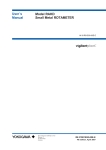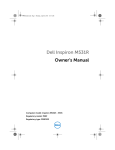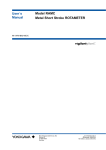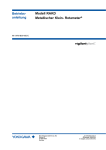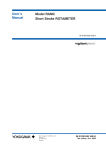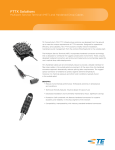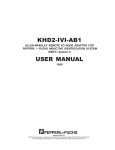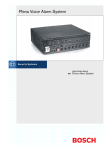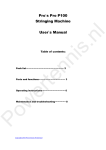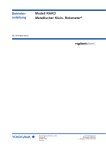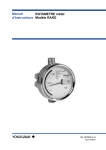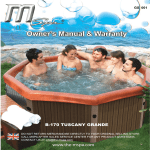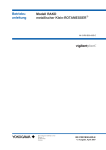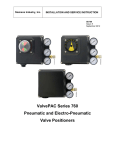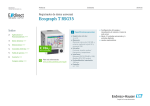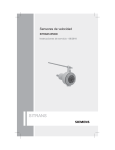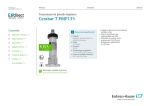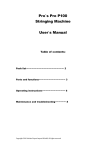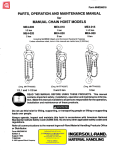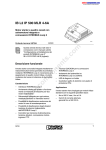Download User´s Manual Model RAKD Small Metal ROTAMETER
Transcript
User´s Manual Model RAKD Small Metal ROTAMETER IM 01R01B30-00E-E Rota Yokogawa GmbH & Co. KG Rheinstr. 8 D-79664 Wehr Germany IM 01R01B30-00E-E 2003 (Rü) 5th edition, January 2013 (Rü) ©Copyright Blank Page <CONTENTS> i Contents 1. Introduction..........................................................................................1-1 1.1 ATEX Documentation.......................................................................................1-3 1.2 General description..........................................................................................1-4 1.3 Principle of measurement...............................................................................1-4 1.4 Overview............................................................................................................1-5 2. Precautions..........................................................................................2-1 2.1 Transportation and Storage............................................................................2-1 2.2 Installation........................................................................................................2-1 3. Installation...........................................................................................3-1 3.1 Installation in the pipeline..............................................................................3-1 3.2 Wiring ...............................................................................................................3-1 3.2.1 Connecting diagrams........................................................................................... 3-1 3.2.2 Conductor connection with Quickon ................................................................ 3-4 3.2.3 Conductor M12 connection (Option /A29 or /A30) ......................................... 3-6 4. Start of operation................................................................................4-1 4.1 Hints on flow rate measurement....................................................................4-1 4.2 Pulsation and pressure shock........................................................................4-1 4.3 Start of operation of electronic transmitter..................................................4-1 5. Limit switches (Option /K1 to /K10) ..............................................................................5-1 All Rights Reserved. Copyright © 2003, Rota Yokogawa IM 01R01B30-00E-E 5th edition January 01, 2013 -00 ii <CONTENTS> 6. Service........................................................................................................... 6-1 6.1 Maintenance.....................................................................................................6-1 6.1.1 Function test.......................................................................................................... 6-1 6.1.2 Measuring tube, float............................................................................................ 6-1 6.1.3 Explosion drawings.............................................................................................. 6-2 6.1.4 Electronic transmitter........................................................................................... 6-3 6.1.5 Exchange of scale................................................................................................. 6-3 6.1.6 Exchange of indicator........................................................................................... 6-3 6.1.7 Troubleshooting..................................................................................................... 6-4 6.2 Template for sending back to service...........................................................6-5 7. Technical Data......................................................................................7-1 7.1 RAKD Type-, Suffix-codes and Options..........................................................7-1 7.2 Standard Specifications...................................................................................7-6 7.3 Dimensions and weights............................................................................... 7-11 7.4 Temperature curves ....................................................................................... 7-15 8. Explosion-protected Type Instruments.............................................8-1 8.1 General..............................................................................................................8-1 8.2 Intrinsically safe ATEX certified RAKD (/KS1)..............................................8-2 8.2.1 Technical data....................................................................................................... 8-2 8.2.2 Installation............................................................................................................. 8-4 8.3 Intrinsically safe IECEx certified RAKD (/ES1).............................................8-5 8.3.1 Technical data....................................................................................................... 8-5 8.3.2 Installation............................................................................................................. 8-7 8.4 Non incendive RAKD for Category 3 (ATEX) (/KN1)....................................8-8 8.5 Dust proofed limit switches (ATEX) (/KS2)...................................................8-8 8.6 Intrinsically safe "ic" RAKD for Category 3G (ATEX /IECEx) (/KS3, /ES3).8-9 8.7 Intrinsically safe FM / CSA (USA + Canada) components (/FS1, /CS1).............8-10 8.7.1 Limit switches option /K1 ... /K10 (/FS1 for USA)............................................. 8-10 8.7.2 Limit switches option /K1 ... /K10 (/CS1 for Canada)....................................... 8-10 8.8 Intrinsically safe NEPSI (China) certified RAKD (/NS1)....................................... 8-16 IM 01R01B30-00E-E 5th edition January 01, 2013 -00 All Rights Reserved. Copyright © 2003, Rota Yokogawa <CONTENTS> iii APPENDIX 1. Safety Instrumented Systems Installation................... A1-1 A1.1 Scope and Purpose.................................................................................... A1-1 A1.2 Using RAKD for a SIS Application............................................................ A1-1 A1.2.1 Safety Function.................................................................................................. A1-1 A1.2.2 Diagnostic Response Time............................................................................... A1-2 A1.2.3 Setup................................................................................................................... A1-2 A1.2.4 Proof Testing...................................................................................................... A1-2 A1.2.5 Repair and replacement.................................................................................... A1-2 A1.2.6 Startup Time....................................................................................................... A1-3 A1.2.7 Reliability data................................................................................................... A1-3 A1.2.8 Lifetime limits..................................................................................................... A1-3 A1.2.9 Environmental limits.......................................................................................... A1-3 A1.2.10 Application limits............................................................................................. A1-3 A1.3 Definitions and Abbreviations.................................................................... A1-4 A1.3.1 Definitions.......................................................................................................... A1-4 A1.3.2 Abbreviations..................................................................................................... A1-4 A1.4 Assessment results..................................................................................... A1-5 A1.4.1 Safety related parameters................................................................................. A1-5 All Rights Reserved. Copyright © 2003, Rota Yokogawa IM 01R01B30-00E-E 5th edition January 01, 2013 -00 iv <CONTENTS> Blank Page IM 01R01B30-00E-E 5th edition January 01, 2013 -00 All Rights Reserved. Copyright © 2003, Rota Yokogawa <1. INTRODUCTION> 1-1 1. Introduction Before use, read this manual thoroughly and familiarize yourself fully with the features, operations and handling of Rotameter RAKD to have the instrument deliver its full capabilities and to ensure its efficient and correct use. Notices Regarding This Manual • This manual should be passed to the end user. • The contents of this manual are subject to change without prior notice. • All rights reserved. No part of this document may be reproduced or transmitted in any form or by any means without the written permission of Rota Yokogawa (hereinafter simply referred to as Yokogawa). • This manual neither does warrant the marketability of this instrument nor it does warrant that the instrument will suit a particular purpose of the user. • Every effort has been made to ensure accuracy in the contents of this manual. However, should any questions arise or errors come to your attention, please contact your nearest Yokogawa sales office that appears on the back of this manual or the sales representative from which you purchased the product. • This manual is not intended for models with custom specifications. • Revisions may not always be made in this manual in conjunction with changes in specifications, constructions and/or components if such changes are not deemed to interfere with the instrument’s functionality or perfor-mance. Notices Regarding Safety and Modification • For the protection and safety of personnel, the instrument and the system comprising the instrument, be sure to follow the instructions on safety described in this manual when handling the product. If you handle the instrument in a manner contrary to these instructions, Yokogawa does not guarantee safety. • If this instrument is used in a manner not specified in this manual, the protection provided by this instrument may be impaired. • As for explosion proof model, if you yourself repair or modify the instrument and then fail to return it to its original form, the explosion protected construction of the instrument will be impaired, creating a hazardous condition. Be sure to consult Yokogawa for repairs and modifications. All Rights Reserved. Copyright © 2003, Rota Yokogawa The following safety symbols and cautionary notes are used on the product and in this manual: WARNING This symbol is used to indicate that a hazardous condition will result which, if not avoided, may lead to loss of life or serious injury. This manual describes how the operator should exercise care to avoid such a risk.. CAUTION This symbol is used to indicate that a hazardous condition will result which, if not avoided, may lead to minor injury or material damage. This manual describes how the operator should exercise care to avoid a risk of bodily injury or damage to the instrument. IMPORTANT This symbol is used to call your attention to a condition that must be observed in order to avoid the risk of damage to the instrument or system problems. NOTE This symbol is used to call your attention to information that should be referred to in order to know the operations and functions of the instrument. For Safe Use of Rotameter RAMC WARNING • If the process fluid is harmful to personnel, handle Rotameter RAKD carefully even after it has been removed from the process line for maintenance or other purposes. Exercise extreme care to prevent the fluid from coming into contact with human flesh and to avoid inhaling any residual gas. • In case of Explosion proof type instrument, further requirements and differences are described in Chapter 8 " INSTRUCTIONS FOR EXPLOSION PROTECTED RAKD”. The description in Chapter 8 is prior to other descriptions in this instruction manual. IM 01R01B30-00E-E 5th edition January 01, 2013 -00 1-2 <1. INTRODUCTION> WARNING CAUTION • When carrying Rotameter RAKD around, exercise extreme care to avoid dropping it accidentally and causing bodily injury. Warranty • The warranty of this instrument shall cover the period noted on the quotation presented to the Purchaser at the time of purchase. The Seller shall repair the instrument free of charge when the failure occurred during the warranty period. • All inquiries on instrument failure should be directed to the Seller’s sales representative from whom you purchased the instrument or your nearest sales office of the Seller. • Should the instrument fail, contact the Seller specifying the model and instrument number of the product in question. Be specific in describing details on the failure and the process in which the failure occurred. It will be helpful if schematic diagrams and/or records of data are attached to the failed instrument. • Whether or not the failed instrument should be repaired free of charge shall be left solely to the discretion of the Seller as a result of an inspection by the Seller. • When removing the instrument from hazardous processes, avoid contact with the fluid and the interior of the meter. • In case of Explosion proof type instrument, further requirements and differences are described in Chapter 8 " INSTRUCTIONS FOR EXPLOSION PROTECTED RAKD”. The description in Chapter 8 is prior to other descriptions in this instruction manual.. Restriction on Use of Radio Transceiver IMPORTANT Although the transmitter has been designed to resist high frequency electrical noise, if a radio transceiver is used near the transmitter or it external wiring, the transmitter may be affected by high frequency noise pickup. To test for such effects, bring the transceiver in use slowly from a distance of several meters from the transmitter, and observe the measurement loop for noise effects. Thereafter, always use the transceiver outside the area affected by noise. The Purchaser shall not be entitled to receive repair services from the Seller free of charge, even during the warranty period, if the malfunction or damage is due to: • improper and/or inadequate maintenance of the instrument in question by the Purchaser. • handling, use or storage of the instrument in question beyond the design and/or specifications requirements. • use of the instrument in question in a location not conforming to the conditions specified in the Seller’s General Specification or Instruction Manual. • retrofitting and/or repair by an other party than the Seller or a party to whom the Seller has entrusted repair services. • improper relocation of the instrument in question after delivery. • reason of force measure such as fires, earthquakes, storms/ floods, thunder/lightning, or other reasons not attributable to the instrument in question. IM 01R01B30-00E-E 5th edition January 01, 2013 -00 All Rights Reserved. Copyright © 2003, Rota Yokogawa <1. INTRODUCTION> 1-3 1.1 ATEX Documentation This is only applicable to the countries in European Union. GB DK SK CZ I LT E LV NL EST PL SF SLO P H F BG D RO S M GR All Rights Reserved. Copyright © 2003, Rota Yokogawa IM 01R01B30-00E-E 5th edition January 01, 2013 -00 1-4 <1. INTRODUCTION> 1.2 General description This manual describes installation, operation and maintenance of the RAKD. Please read it carefully before using this device. Further, please note that customer features are not described in this manual. When modifying specifications, construction or parts, this manual is not necessarily revised unless it can be assumed that these changes will impair RAKD functions or performance. All units are thoroughly tested before shipping. Please check the received units visually to ensure that they have not been damaged during transport. In case of defects or questions please contact your nearest YOKOGAWA service centre or sales office. Please describe any defect precisely and indicate model code as well as com. no. number. YOKOGAWA refuses any liability for units which have been repaired by the user without prior consent and do not meet the specifications as a consequence.. 1.3 Principle of measurement The RAKD is a Variable Area Flow Meter for volume and mass measurements of gases and liquids. A float, whose movement is nearly independent of viscosity is guided concentrically in a specially shaped cone. The position of the float is transferred magnetically to the indicator, which shows the measurement values by a pointer on a scale. The indicator can be equipped with limit switches and an electronic transmitter. F10.EPS Fig. 1.1 All units are calibrated with water or air by the manufacturer. By adjusting the calibration values to the measured substance’s state of aggregation (density, viscosity), the flow rate scale for each measuring tube can be determined. IM 01R01B30-00E-E 5th edition January 01, 2013 -00 All Rights Reserved. Copyright © 2003, Rota Yokogawa 1-5 <1. INTRODUCTION> 1.4 Overview Tube Limit switch MAX below scale Indicator Cable connection Quickon Pointer Limit switch MIN below scale Scale F11.EPS Example for scale : Com. no.. Flow scale 100 Flow unit Manufactured: 2009 Kom.Nr.: 200000/001 MS-Code: RAKD41-G6SS-33NNNE80424/K1/KS1 Wasser 0,99831 g/cm 1 mPas 20 Grad C 1.1 bar abs. 50 Ex-marking Ex-data electronic transmitter Limit switch Ex-data limit switch Model code Made in Germany D-79660 Wehr Medium data l/h 10 KEMA 00ATEX 1037X Ex ia IIC T6 Transmitter Ui= 30V Ii= 100mA Pi= 0.75W Li= 0.73mH Ci= 2.4nF Limit Switch: SC2-N0 KEMA 00ATEX 1037X Ex ia IIC T6 see certificate for data II2G Ex-marking F12.EPS All Rights Reserved. Copyright © 2003, Rota Yokogawa IM 01R01B30-00E-E 5th edition January 01, 2013 -00 1-6 <1. INTRODUCTION> Blank Page IM 01R01B30-00E-E 5th edition January 01, 2013 -00 All Rights Reserved. Copyright © 2003, Rota Yokogawa 2-1 <2. PRECAUTIONS> 2. Precautions 2.1 Transportation and Storage Before transporting the unit, it is recommended to fix the float with a card-board strip in the same way as when shipped from factory. Prevent foreign objects from entering the tube (e.g. by covering openings). To protect the unit and especially the tube’s interior from soiling, store it only at clean and dry locations 2.2 Installation Ambient temperature and humidity of the installation location must not exceed the specified ranges. Avoid locations in corrosive environments. If such environments are unavoidable, ensure sufficient ventilation. Although the RAKD features a very solid construction, the instrument should not be exposed to strong vibration or impact stress. Please note that the RAKD is magnetic sensing system can be influenced by external inhomogeneous magnetic fields (such as solenoid valves). Alternating magnetic fields (≥ 10Hz) as well as homogeneous, static magnetic fields (in the area of the RAKD), like the geomagnetic field have no influence. Asymmetric ferromagnetic bodies of considerable mass (e.g. steel girders) should be kept at a distance of at least 250 mm from the RAKD. To avoid interference, the distance between two adjacent RAKDs must be at least 120 mm. Do not expose the unit to pressures higher than the indicated maximum operating pressure (refer to specifications) Make sure that wetted parts are resistant against the process medium. Ambient- and process-temperature may exceed specified maximum values. Note the temperature curves in fig. 2-1 and chapter 7 "Technical data". The Rotameter must be mounted vertically. The flow direction is upwards. Illustration of maximum allowable operation temperature depending on ambient temperature for Rotameter type RAKD 275 250 Max. operation temperature [°C] 225 200 175 150 125 100 75 50 55 60 65 70 75 80 Ambient temperatur [°C] Version without valve Version with valve F21.EPS Fig. 2-1. For option /KS1or /KN1 (Ex-version) the maximum values for ambient and process temperature according to the respective temperature class mentioned in fig. 3-2 and tables 7-2 to 7-5 must be regarded. The minimum ambient temperature is -25°C. All Rights Reserved. Copyright © 2003, Rota Yokogawa IM 01R01B30-00E-E 5th edition January 01, 2013 -00 2-2 <2. PRECAUTIONS> Check movability of the float (5)* by watching the pointer. The pointer should follow the movement of the float. If this is not the case, float and measuring tube (1;21) should be cleaned. Check the movability of the pointer by careful moving it with your fingers and watching whether it responds to the scale value. If it does not work properly, the mechanical display unit (14) must be changed. To avoid damage of the float and of the stopper do not use magnetic valves. In the phase of start up increase the flow slowly to the desired flow rate. If a sudden rise of the pressure can not be avoided (with use of magnetic valves) the flow must be limited to the maximum used value (e.g. by valve). *: Position numbers are illustrated in the explosion drawings in chapter 6. IM 01R01B30-00E-E 5th edition January 01, 2013 -00 All Rights Reserved. Copyright © 2003, Rota Yokogawa 3-1 <3. INSTALLATION> 3. Installation 3.1 Installation in the pipeline The pipe has to be so stabilized that vibrations on the pipe are avoided. Additional recommendations can be found in guideline VDI/VDE 3513 sheet 3. If pollution of the metering tube may appear a bypass-pipe is recommended, which permits the removal (see. chapter 6 “maintenance”) of the Rotameter for cleaning without interruption of the flow. Before installing the Rotameter, make sure there are no parts of packing or securing inside the Rotameter. It has to be taken care at the connection of units with internal thread that no residues of the sealing compound come into the tube (e.g. remains of the PTFE sealing compound). To avoid stress in the connecting pipes, the connecting flanges must be aligned in parallel and axial direction. Bolts and gaskets have to be selected according to the maximum operating pressure, the temperature range and corrosion conditions. Centre gaskets and tighten nuts with a torque appropriate for the pressure range. If contamination or soiling of the RAKD is to be expected, a bypass should be installed to allow the removal of the instrument without interruption of the flow. Please read also chapter 2.2. For further instructions on installation please refer to VDI/VDE3513. In case of devices without valve but with process connection internal thread the float shaft of tubes with cone 44 and bigger sizes may move into the range of the threaded joint. Keep attention not to bend the guide bar when screwing up the connection. The inner diameter of the connector must be at least 8 mm for cone sizes 44 - 51 resp. 10 mm for cone sizes 52 and 53. To avoid float bouncing in case of gas applications, attend to VDI/VDE 3515 sheet 3. For devices without valve use a throttle either in the inlet or outlet (to install at that side with the bigger volume). For installation of several instruments in parallel tubes take care that the distance between the middle axis is at least 120 mm to avoid magnetic influence. The distance to other ferritic material should not be less than 60 mm. Take care that the strength of external magnetic fields is approximately 0 mT. 3.2 Wiring 3.2.1 Connecting diagrams Please regard the drawings of this chapter. RAKD with electronic transmitter or with limit switches have one or two Quickon connectors at the rear. In the connecting diagrams he lower one is named "S" and the upper one "T". Not used connector positions are closed with a blind plug. The following table shows the connections for the respective equipment configuration. Type T without contact Type T with MIN contact /K1 or /K6 Type T with MAX contact /K2 or /K7 Quickon upper "T" --- --- MAX contact Quickon lower "S" --- MIN contact --- Type T with MIN/MAX contact / K3 or /K8 Type E without contact without pulse Type E with MIN contact /K1 or /K6 Type E with MAX contact /K2 or /K7 Type E with pulse output /CP MAX contact Current output Current output Current output Current output MIN contact --- MIN contact MAX contact Puls output T31.EPS The load resistance of metering or indicating instruments, which are connected serial to the current output, may not exceed (U- 13.5 V) / 20 mA . All Rights Reserved. Copyright © 2003, Rota Yokogawa IM 01R01B30-00E-E 5th edition January 01, 2013 -00 3-2 <3. INSTALLATION> RAKD-E80 G + - F 2 + T Power supply U RL 1 4-20mA Power supply U / V RL / Ω 13.5V ...30V < (U-13.5V) / 20mA T = QUICKON connector Fig. 3-1 RAKD with electronic Transmitter Hazardous Area Safe Area Supply 230V AC 14 ~ RAKD - T80 F 1 + BU - T 1 2 + 3 - + - S 1 4 BN MIN ~ U BN MAX 15 BU 6 2 Limit Switches EN 60947-5-6 (NAMUR) Limit Switch Type 2 Ex ia IIC T6...T4 Gb Ui = 16V Ii = 25mA Pi = 64mW Ci = 150nF Li = 0.15mH 9 8 Limit MAX 7 12 + - 11 Limit MIN 10 Transmitter Relay KFA6-SR2-Ex2.W KFA6-SR2-Ex2.W Ex ia IIC Uo = 10.6V Io = 19,1mA Po = 51mW Co = 2320nF Lo= 97mH KEMA 00ATEX 1037X PTB 00ATEX 2081 Fig. 3-2 IM 01R01B30-00E-E F3.EPS RAKD with 2 limit switches in combination with transmitter relay in Ex- version 5th edition January 01, 2013 -00 All Rights Reserved. Copyright © 2003, Rota Yokogawa 3-3 <3. INSTALLATION> Hazardous Area Safe Area RN221N-B1 4-20mA output Ex ia IIC T6...T4 Gb U i = 30V Ii = 100mA Pi = 0.75W Ci = 2.4nF Li = 0.73mH KEMA 00ATEX 1037X [Ex ia] IIC Uo = 27.3V Io = 87.6mA Po = 0.597W Co = 86nF Lo = 5.2mH Tamax = 50°C PTB 00ATEX 2018 Transmitter power supply Option: /UT RAKD-E80 Option /KS1 G L+ 2 I+ 1 I- O+ T L- F N/1 BN+ BU- S 2 1K 1 15 K P+ S P2 Limit switch or Pulse output EN 60947-5-6 (NAMUR) Output 4-20mA OL/+ 14 ~ 15 ~ U 1 + 3 - Power supply 230V AC 9 8 Limit switch / Puls 7 Transmitter relay Option: /W2A KFA6-SR2-Ex1.W Puls output Ex ia IIC T6...T4 Gb U i = 16V I i = 20mA P i = 64mW C i = 0nF L i = 0mH KEMA 00ATEX 1037X Fig. 3-3 Limit switch type 2 Ex ia IIC T6...T4 Gb U i = 16V I i = 25mA P i = 64mW C i = 150nF L i = 0.15mH KEMA 00ATEX 1037X [Ex ia] IIC Uo = 10.6V I o = 19.1mA Po = 51mW Co = 2320nF Lo = 97mH PTB 00ATEX 2081 RAKD in Ex-version with electronic transmitter in combination with power supply and additional limit switch or pulse output with transmitter relay. All Rights Reserved. Copyright © 2003, Rota Yokogawa IM 01R01B30-00E-E 5th edition January 01, 2013 -00 3-4 <3. INSTALLATION> 3.2.2 Conductor connection with Quickon To connect the conductor, please observe in particular the following steps : - Strip the sheath to a length of approx. 15 mm (fig. 3-4) and slide the union nut (1), the cap (2) and the rubber seal (3) onto the conductor. 5 3 2 4 1 15 mm Fig. 3-4 F6.EPS F7.EPS Fig. 3-5 - Slide the rubber seal as far as the rim of the insulation and then slide the cap onto the rubber seal. This provides the strain relief for the conductor (fig. 3-5). IM 01R01B30-00E-E 5th edition January 01, 2013 -00 All Rights Reserved. Copyright © 2003, Rota Yokogawa 3-5 <3. INSTALLATION> - insert the core ends into the feed through of the splice ring (fig. 3-6). In order to guarantee a clear assignment of the cores, the individual core feed thorough of the splice ring are numbered (1, 2,…). Fig. 3-6 - Cut off the projecting core ends. Make sure that the core ends are flush with the splice ring (5): they can protrude by up to 3 mm, but must not be too short. F8.EPS - Insert the prepared conductor into the QUICKON contact carrier (4). Turn the conductor with the splice ring until the coding noses fit exactly into the corresponding guides (fig. -). Fig. 3-7 - Close the gland by tightening the union nut. This presses the core ends into the insultation displacement terminal blocks, cuts open the core insulation and creates the electrical contact (IDC connection system). F9.EPS All Rights Reserved. Copyright © 2003, Rota Yokogawa IM 01R01B30-00E-E 5th edition January 01, 2013 -00 3-6 <3. INSTALLATION> 3.2.3 Conductor M12 connection (Option /A29 or /A30) Fig. 3-8 Angular mating connector is only factory delivered with option /A30. Pin assignment: Connection Signal Upper connector 1 (+) 2 (-) One limit switch /K1, /K2, /K6, /K7 Two limit switches /K3, /K8, /K9, /K10: lower switch, e.g. MIN MAX ==> MIN Upper connector 3 (+) 4 (-) Two limit switches /K3, /K8, /K9, /K10: upper switch, e.g. MIN MAX ==> MAX Lower connector 1 (+) 2 (-) Electronic transmitter, 4-20 mA supply Lower connector 3 (+) 4 (-) Electronic transmitter, pulse output (option /CP) IM 01R01B30-00E-E 5th edition January 01, 2013 -00 All Rights Reserved. Copyright © 2003, Rota Yokogawa 4-1 <4. START OF OPERATION> 4. Start of operation 4.1 Hints on flow rate measurement The measured fluid should neither consist of a multi-phase mixture nor contain ferrite ingredients or large solid mass particles. The RAKD scale is adjusted to the state of operation/aggregation of the measured fluid by the manufacturer. If the state of operation changes, it might become necessary to establish a new scale. This depends on several factors: - If the RAKD is operated in the given viscosity independent range, only the density of the float as well as the operational density of the previous and new substance have to be considered. In case the operational density only changes marginally (≤ 0.5%), the present scale can be used. - If the RAMC is operated outside the given viscosity independent range, the viscosities at the previous and new state of operation as well as the mass and diameter of the float have to be taken into account. To establish a new scale, please refer to the folder “Anweisung zur Skalenumrechnung” (Instructions for Scale Conversion) as well as the conversion table or order a new scale. 4.2 Pulsation and pressure shock Strong pressure impact or flow pulsations can impair measuring operation considerably and should be avoided open valves slowly, raise operating pressure slowly). 4.3 Start of operation of electronic transmitter Ensure that the device has been connected correctly according to section 3-2 and that the used power supply meets the requirements indicated on the scale. Switch on the power supply.. The RAMC is now ready for operation.. The transmitter is prepared and calibrated according to its model code as a 2 wire unit. All Rights Reserved. Copyright © 2003, Rota Yokogawa IM 01R01B30-00E-E 5th edition January 01, 2013 -00 4-2 <4. START OF INSTALLATION> Blank Page IM 01R01B30-00E-E 5th edition January 01, 2013 -00 All Rights Reserved. Copyright © 2003, Rota Yokogawa 5-1 <5. LIMIT SWITCHES OPTION /K1 TO /K10> 5. Limit switches (Option /K1 to /K10) The optional limit switches are available as maximum or minimum type switches. They are proximity switches according to EN 60947-5-6 (NAMUR). Maximal two switches can be installed. The option (/Wnn) includes the respective transmitter relay. These switches have been specified for hazardous area. However, the transmitter relay must be installed in safe area. The limit switches are connected to the transmitter relays as indicated in chapter 3.2. The terminals for the limit switches are on a small board on top of the transmitter case. Use of 2 standard limit switches (option /K3): The MIN-MIN and MAX-MAX functions have been integrated at the factory as MIN-MAX switches in the RAKD The MIN-MIN or MAX-MAX function is set by adjusting the switching direction of the transmitter relay. The concerning 2- channel transmitter relays are: Option /W1B: KFA5-SR2-Ex2.W Option /W2B: KFA6-SR2-Ex2.W Option /W4B: KFD2-SR2-Ex2.W The following table shows the assignment: Function Switching direction of transmitter relay * Channel 1 Channel 2 Channel 1 Channel 2 MIN MAX S1 position I S2 position I MIN MIN S1 position I S2 position II (ON) MAX MAX S1 position II (ON) S2 position I * see following figure for S1 and S2 on transmitter relay. Use of Fail Safe limit switches (option /K6 ... /K10): For Fail Safe application only 1- channel transmitter relays are available. Option Option Option Option /W2E: /W2F: /W4E: /W4F: KHA6-SH-Ex1.W 2 x KHA6-SH-Ex1.W KFD2-SH-Ex1.W 2 x KFD2-SH-Ex1.W If other transmitter relays are used as the above mentioned types, the transmitter relay has to be applied as protection technology to ensure functional safety. Please notice chapter 7.2 "Standard specifications". For questions regarding protection technology, please consult your YOKOGAWA service center. All Rights Reserved. Copyright © 2003, Rota Yokogawa IM 01R01B30-00E-E 5th edition January 01, 2013 -00 5-2 <5. LIMIT SWITCHES OPTION /K1 TO /K10> Blank Page IM 01R01B30-00E-E 5th edition January 01, 2013 -00 All Rights Reserved. Copyright © 2003, Rota Yokogawa <6. SERVICE> 6-1 6. Service 6.1 Maintenance 6.1.1 Function test Checking free movement of pointer: - Remove housing cover (4 screws). - After deflecting the pointer by hand, it must return to measurement value. If the pointer pivots to different values upon repeated deflections, there is too much friction in the bearings. In this case, send indication unit to service. Checking free movement of float: - First, free movement of pointer has to be ascertained. - Check visually if pointer follows each flow rate change. If not, clean float and measuring tube. Unit with electronic transmitter: - Without flow, the output current must be 4 mA. At a flow rate of 100% the current must be 20 mA. If only the pointer is moved to 100%, the current may not exeed 17mA. 6.1.2 Measuring tube, float The Rotameter does not normally require any maintenance. However cleaning is necessary if the measuring cone or flat has been contaminated by the process. To clean, the Rotameter must be removed from the pipeline. For all kind of intervention in the Rotameter like tightening the packing of the valve the pressures in pressurized pipelines has to be reduced. Take care that the counter screw is tighten after screwing the valve. Disassembling the tube Please perform the following steps to clean the measuring tube and the float: • Disassemble the Rotameter from the pipe • Unscrew hollowed top threaded bolt (6) (for cone 31 – 43) resp. remove top snap ring and socket (for cone 44 – 51) resp. only top snap ring (for cone 52 – 53) • Remove top float stop (3) • Disassemble float – Attention: Do not bend the float • For version with valve in the inlet remove first the top head pipe plug (8) • For version with valve in the outlet remove first the lower head pipe plug; in that case the disassembling of all parts start from down to top • Cleaning of metering tube and float • To clean the valve loose screw nut (10) in the head. Afterwards you can unscrew spindle (12) with PTFE packing box plus thrust collar (9) IMPORTANT Please don’t expose the float to any strong magnetic alternating fields. The floating body and particularly its measuring edge may not be damaged. Assembling the tube Mounting starts in opposite sequence. Assembling the float take care that the lower guide bar of the float is fixed in the middle boring of the lower stop. The guide bar should not be bended. All Rights Reserved. Copyright © 2003, Rota Yokogawa IM 01R01B30-00E-E 5th edition January 01, 2013 -00 6-2 <6. SERVICE> 6.1.3 Explosion drawings No. in Fig. 6-1 and 6-2 Part 1 Tube for unit with valve and controller 2 Socket 3 Float stop 4 Cone 5 Float 6 Threaded bold 7 Gasket 8 Screw sealing plug 9 ; 10; 11; 12; 13 Packing for valve 14 Indicator 15 Nut M5 16; 19 Nozzle 17; 20 Cutting ring fitting 18 Controller 21 Tube for unit without valve and controller F61.EPS Fig. 6-1 RAKD without valve and controller F62.EPS Fig. 6-2 RAKD with valve and controller IM 01R01B30-00E-E 5th edition January 01, 2013 -00 All Rights Reserved. Copyright © 2003, Rota Yokogawa <6. SERVICE> 6-3 6.1.4 Electronic transmitter The electronic transmitter is maintenance-free. The electronic section is sealed and can not be repaired. The transmitter is tuned with the mechanical components in factory, therefore single components can be replaced only by loss of accuracy. 6.1.5 Exchange of scale Preparations : · Check commision no., code, and data of new parts. · Switch off power supply. · Remove the cover of the indicator IMPORTANT Do not bend or twist the pointer on its axis ! Exchange of scale: - Untighten the screw of the scale. - Remove the screw and the small cover. - Pull the scale out of the indicator to the left in which the scale raised on the right to raise it from the 2 pins. - Shove the new scale correspondingly below the pointer from the left until the 2 pins click into the accompanying holes. - Establish the small cover and fix the scale with the screw. Final actions: · Fix the cover of the indicator. · Switch power on. · Check the unit for a faultless function. 6.1.6 Exchange of indicator The indicator can be replaced by the same type if the scale of the old unit is put into the new indicator, Procedure with RAKD with electronic transmitter (type "E" ): · Switch off power supply. · Remove the cover of the indicator - Disconnect the cables from the Quickon connectors. - Remove the old scale and put in the new one. IMPORTANT - Please not the hints for exchange of scale - Remove the old indicator from the tube and replace it by the new one. Please take care to mount the washers and spacers in the same positions as they were before dismantling. All Rights Reserved. Copyright © 2003, Rota Yokogawa IM 01R01B30-00E-E 5th edition January 01, 2013 -00 6-4 <6. SERVICE> 6.1.7 Troubleshooting In case the RAMC does not work properly, use the following flow charts for troubleshooting, then check, isolate and remedy the fault. Precision problems with "T" unit: execute test acc. fig. 6-3 If the indicated countermeasure do not remedy the fault or in case of troubles which cannot be remedied by the user, please contact your YOKOGAWA service centre. F63.EPS Fig. 6-3 IM 01R01B30-00E-E 5th edition January 01, 2013 -00 All Rights Reserved. Copyright © 2003, Rota Yokogawa <6. SERVICE> 6-5 6.2 Template for sending back to service Sending an instrument back to service Installation and operation of the Rotameter RAKD in compliance with this manual is generally trouble-free. In case a RAKD has to be sent for repairs or checking to our service, please observe the following: Due to legislation for the protection of the environment and for the safety of our staff, YOKOGAWA may only ship, repair and check sent devices on the condition that this does not constitute any risk to environment and staff. YOKOGAWA can only process your returned RAKD if you attach a certificate of harmlessness according to the following sample. If the unit has been in contact with corrosive, poisonous, flammable or water polluting substances, you must, - ensure that all parts and hollow spaces of the unit are free of these dangerous substances. - attach a certificate of harmlessness to the returned unit. Please understand that YOKOGAWA cannot process your returned unit without such a certificate. All Rights Reserved. Copyright © 2003, Rota Yokogawa IM 01R01B30-00E-E 5th edition January 01, 2013 -00 6-6 <6. SERVICE> ROTA YOKOGAWA GmbH & Co. KG Service & Repair Department Rheinstraße 8; D - 79664 Wehr Phone no.: +49 (0)7761-567-190 Fax no.: +49 (0)7761-567-285 e-Mail: [email protected] Declaration of Decontamination Legal regulations for the safety of our employees and operating equipment determine that we need the declaration of decontamination before your order can be handled. Please make sure to include it with the shipping documents, attached to the outside of the packaging you use for shipment. Customer data Company: Address: Contact person: E-Mail: Phone no.: Fax no.: Reference/Order no.: Instrument data* Type: Serial no.: Type: Serial no.: *If not enough, note on separate sheet Process data Process medium: Medium is: [ [ [ [ [ [ ] ] ] ] ] ] toxic corrosive explosive biological hazardous unknown if dangerous non hazardous Remarks: Cleaning agent: Kind of cleaning : Other remarks / Reason of return: We hereby confirm that this statement is filled in completely and truthfully. The returned instruments were carefully cleaned and are thus free from product residue and dirt. I agree that if this arrangement does not match with the instruments, they will be sent back to the above mentioned customer address at our expenses. Name IM 01R01B30-00E-E Date 5th edition January 01, 2013 -00 Signature All Rights Reserved. Copyright © 2003, Rota Yokogawa 53 54 55 56 53 P1 54 P1 53 W3 54 W3 55 W3 56 W3 Nozzle: Ø 6 PN 10 Ø 8 PN 10 Swagelok: Ø 6 PN 25 Ø 8 PN 25 Ø 10 PN 25 Ø 12 PN 25 C3 C3 C3 C3 41 R3 41 T3 ------- Ø 6 PN 25 Ø 8 PN 25 Ø 10 PN 25 Ø 12 PN 25 Cutting ring: Internal thread: Rp 1/4 PN 25 1/4 NPT PN 25 Process connection RAKD All Rights Reserved. Copyright © 2003, Rota Yokogawa Material: 1.4571 / AISI 316Ti SS 200 325 500 800 1400 2000 3250 Dp mbar 6 8 11 6 10 16 25 40 60 100 Cone 31 - 37 41 - 43 44 - 51 37 41 42 43 44 47 51 31 32 33 34 Water (l/h) 1 1.6 1.5 4 Air (l/h) 40 60 100 150 Cone Max. Flow SS ------------- With valve in outlet Gasket Valve seat PTFE Silver VSA PTFE PCTFE VPA With valve in inlet Gasket Valve seat PTFE Silver VSE PTFE PCTFE VPE Version Power supply: none, for type ´T´ 24V, 2- wire, 4 - 20mA, for type ´E´ Stainless steel Housing type: Type: Local indicator Indicator wit electronic output Indicator ------------------------------------------ NNN 424 80 T E 80 / options <7. TECHNICAL DATA> IM 01R01B30-00E-E 7-1 7. Technical Data 7.1 RAKD Type-, Suffix-codes and Options RAKD with valve and controller (option /R1 and /R3) 1.0 - 100 l/h water / 40 - 3250 l/h air 5th edition January 01, 2013 -00 IM 01R01B30-00E-E 5th edition January 01, 2013 -00 53 P1 54 P1 Nozzle: Ø 6 PN 10 Ø 8 PN 10 55 W3 55 W6 56 W3 56 W6 Ø 10 PN 40 Ø 12 PN 40 Ø 12 PN 100 54 W6 Ø 8 PN 100 Ø 10 PN 100 53 W6 54 W3 Ø 8 PN 40 53 W3 Ø 6 PN 100 Ø 6 PN 40 Swagelok: 53 53 54 54 55 55 56 56 Cutting ring: Ø 6 PN 40 Ø 6 PN 100 Ø 8 PN 40 Ø 8 PN 100 Ø 10 PN 40 Ø 10 PN 100 Ø 12 PN 40 Ø 12 PN 100 C4 C6 C4 C6 C4 C6 C4 C6 41 41 41 41 G4 G6 T4 T6 ------- Internal thread: G 1/4 PN 40 G 1/4 PN 100 1/4 NPT PN 40 1/4 NPT PN 100 Process connection RAKD Material: 1.4571 / AISI 316Ti SS 31 32 33 34 Air (l/h) 40 60 100 150 200 325 500 800 1400 2000 3250 5000 8000 Dp mbar 6 8 11 13 Water (l/h) 1 1.6 1.5 4 6 10 16 25 40 60 100 160 250 Cone 31 - 37 41 - 43 44 - 51 52 - 53 37 41 42 43 44 47 51 52 53 Cone Max. Flow SS ------------- With valve in outlet Gasket Valve seat PTFE Silver VSA PTFE PCTFE VPA With valve in inlet Gasket Valve seat PTFE Silver VSE PTFE PCTFE VPE Version Power supply: none, for type ´T´ 24V, 2- wire, 4 - 20mA, for type ´E´ Stainless steel Housing type: Type: Local indicator Indicator wit electronic output Indicator ------------------------------------------ NNN 424 80 T E 80 / options 7-2 <7. TECHNICAL DATA> RAKD with valve 1.0 - 250 l/h water / 40 - 8000 l/h air All Rights Reserved. Copyright © 2003, Rota Yokogawa All Rights Reserved. Copyright © 2003, Rota Yokogawa IM 01R01B30-00E-E 41 41 41 41 53 53 54 54 55 55 56 C6 56 C7 53 P1 54 P1 Internal thread: G 1/4 PN 100 G 1/4 PN 160 1/4 NPT PN 100 1/4 NPT PN 160 Cutting ring: Ø 6 PN 100 Ø 6 PN 160 Ø 8 PN 100 Ø 8 PN 160 Ø 10 PN 100 Ø 10 PN 160 Ø 12 PN 100 Ø 12 PN 160 Nozzle: Ø 6 PN 10 Ø 8 PN 10 56 W7 Ø 10 PN 160 56 W6 Ø 10 PN 100 Ø 12 PN 100 55 W6 55 W7 Ø 8 PN 160 Ø 12 PN 160 54 W6 54 W7 Ø 8 PN 100 53 W6 53 W7 Ø 6 PN 100 C6 C7 C6 C7 C6 C7 Ø 6 PN 160 Swagelok: 01 A2 02 A2 ANSI 1/2 300 lbs ANSI 1 300 lbs G6 G7 G6 G7 01 02 01 02 D4 D4 A1 A1 ------- Flange: *) DN 15 PN 40 DN 25 PN 40 ANSI 1/2 150 lbs ANSI 1 150 lbs Process connection RAKD Material: 1.4571 / AISI 316Ti Dp mbar 6 8 11 Cone 31 - 37 41 - 43 44 - 51 *) Gasket PTFE SS 200 325 500 800 1400 2000 3250 6 10 16 25 40 60 100 37 41 42 43 44 47 51 31 32 33 34 Water (l/h) 1 1.6 1.5 4 Air (l/h) 40 60 100 150 Cone Max. Flow SS ------------- Power supply: none, for type ´T´ 24V, 2- wire, 4 - 20mA, for type ´E´ Stainless steel Housing type: Type: Local indicator Indicator wit electronic output Without valve NNN Indicator ------------------------------------------- Version NNN NNN 424 80 T E 80 / options <7. TECHNICAL DATA> 7-3 RAKD without valve 1.0 - 100 l/h water / 40 - 3250 l/h air 5th edition January 01, 2013 -00 IM 01R01B30-00E-E 5th edition January 01, 2013 -00 56 C6 56 C7 Cutting ring: Ø 12 PN 100 Ø 12 PN 160 Swagelok: Ø 12 PN 100 *) Gasket PTFE Ø 12 PN 160 42 42 42 42 Internal thread: G 3/8 PN 100 G 3/8 PN 160 3/8 NPT PN 100 3/8 NPT PN 160 56 W7 56 W6 G6 G7 G6 G7 01 02 01 02 01 02 D4 D4 A1 A1 A2 A2 ------- Flange: *) DN 15 PN 40 DN 25 PN 40 ANSI 1/2 150 lbs ANSI 1 150 lbs ANSI 1/2 300 lbs ANSI 1 300 lbs Process connection RAKD Material: 1.4571 / AISI 316Ti SS Cone 52 53 Air (l/h) 5000 8000 Dp mbar 13 Max. Flow Water (l/h) 160 250 Cone 52 - 53 SS ------------- Type: Local indicator Indicator wit electronic output Without valve Power supply: none, for type ´T´ 24V, 2- wire, 4 - 20mA, for type ´E´ Housing type: Stainless steel Indicator NNN ------------------------------------------- Version NNN NNN 424 80 T E 80 / options 7-4 <7. TECHNICAL DATA> RAKD without valve 160 - 250 l/h water / 5000 - 8000 l/h air All Rights Reserved. Copyright © 2003, Rota Yokogawa 7-5 <7. TECHNICAL DATA> OPTIONS Options Option code Description Restriction Indicator /A12 /A29 /A30 US- engineering units M12- connector acc. IEC 61076-2-101 (in preparation) M12- connector with plug connector acc. IEC 61076-2-101 (in preparation) Only for indicator E Only for indicator E or T with limit switches Only for indicator E or T with limit switches Marking /B1 Plate 12 x 40 mm; max. 45 digits /B4 /B8 /B10 /BG /BD Tag plate (SS) fixed by wire and customer specified tag number on scale Neutral version Customer provided marking on label Percent scale With customer specified tag number on scale Dual Scale /K1 /K2 /K3 /K6 /K7 /K8 /K9 /K10 MIN- contact MAX- contact MIN-MAX- contact, MIN-MIN- contact, MAX-MAX- contact MIN- contact “Fail safe” version MAX- contact “Fail safe” version MIN-MAX- contact “Fail safe” version MIN-MIN- contact “Fail safe” version MAX-MAX- contact “Fail safe” version Pulse output /CP Pulse output, acc. EN 60947-5-6 (NAMUR) Only for indicator E; not with limit switches Hazardous area approvals /KS1 /KS2 /KS3 /KN1 /ES1 /ES3 /FS1 /CS1 ATEX intrinsically safe „ia“ ATEX gas and dust proof limit switches, category 2G 1D ATEX intrinsically safe „ic“ ATEX category 3G „nL“ / 3D IECEx intrinsically safe „ia“ IECEx intrinsically safe „ic“ FM intrinsically safe / non incendive limit switches (USA) CSA intrinsically safe / non incendive limit switches (Canada) Not for indicator T without limit switches Only for indicator T with limit switches Not for indicator T without limit switches Not for indicator T without limit switches Not for indicator T without limit switches /NS1 NEPSI approval (China) /H1 /PP /P2 /P3 /P6 /PM1 /PM4 /PM5 Oil + fat free for wetted surfaces Pressure test report measuring system Certificate of Compliance with the order acc. to EN 10204: 2004- 2.1 As /P2 +Test report acc. to EN 10204: 2004- 2.2 Material certificate acc. to EN 10204: 2004- 3.1 PAMI test (1 test point : metering tube) PAMI test (4 test points : metering tube, connection heads, sealing plug) PAMI test (5 test points : metering tube, connection pieces, slip on flanges) Not for /R1 and /R3 Gost approval /QR1 /QR2 /QR3 Primary Calibration and Test Confirmation valid in Russia Primary Calibration and Test Confirmation valid in Kazakhstan Primary Calibration and Test Confirmation valid in Uzbekistan See page 4 See page 4 See page 4 Controller /R1 Pre pressure controller 1.4571 (only with valve in inlet; for gas with variable pre pressure and liquids with variable pre and back pressure) Back pressure controller 1.4571 (only with valve in outlet; for gas with variable back pressure) Only for process connection R3, T3, C3, W3, P1; only with valve Only for process connection R3, T3, C3, W3, P1; only with valve Limit switches Test and certificates /R3 Not with Ex-proof type Max. 45 digits Adjustment only possible for 1 fluid Only for indicator T Only for indicator T Only for indicator T Only for indicator T For indicator T only with limit switches For indicator T only with limit switches; limit switches only /K1, /K2, /K3, only in combination with power supply /WxA or /WxB Not for indicator T without limit switches Only for tube, connection heads, screw sealing plug Only for models with valve Only for models with process connection D4, A1, A2 Delivery to Korea /KC With KC-mark for Korea Power supply for electronic transmitter /UT RN221N-B1, 20 ... 250V DC/AC, Ex i Only for indicator E Power supply for limit switches (transmitter relay) /W1A /W1B /W2A /W2B /W2E /W2F /W4A /W4B /W4E /W4F KFA5-SR2-Ex1.W / 115 V AC, 1 channel KFA5-SR2-Ex2.W / 115 V AC, 2 channel KFA6-SR2-Ex1.W / 230 V AC, 1 channel KFA6-SR2-Ex2.W / 230 V AC, 2 channel KHA6-SH-Ex1 / 115/230 V AC, 1 channel, Fail Safe 2x KHA6-SH-Ex1 / 115/230 V AC, 1 channel, Fail Safe KFD2-SR2-Ex1.W / 24 V DC, 1 channel KFD2-SR2-Ex2.W / 24 V DC, 2 channel KFD2-SH-Ex1 / 24 V DC, 1 channel, Fail Safe 2x KFD2-SH-Ex1 / 24 V DC, 1 channel, Fail Safe Only for limit switches /K1, /K2, /K3 or /CP Only for limit switches /K1, /K2, /K3 Only for limit switches /K1, /K2, /K3 or /CP Only for limit switches /K1, /K2, /K3 Only for limit switches /K6, /K7 Only for limit switches /K8, /K9, /K10 Only for limit switches /K1, /K2, /K3 or /CP Only for limit switches /K1, /K2, /K3 Only for limit switches /K6, /K7 Only for limit switches /K8, /K9, /K10 Instruction manuals /IEn /IDn /IFn Quantity of instruction manuals in English Quantity of instruction manuals in German Quantity of instruction manuals in French n = 1 to 9 selectable *) n = 1 to 9 selectable *) n = 1 to 9 selectable *) Special order /Z Special design must be specification on extra sheet *) if no instruction manual is selected, only a DVD with instruction manuals is shipped with the flowmeter All Rights Reserved. Copyright © 2003, Rota Yokogawa IM 01R01B30-00E-E 5th edition January 01, 2013 -00 7-6 <7. TECHNICAL DATA> 7.2 Standard Specifications The responsibility with respect to the suitability and according application of our flowmeter is only situated by the customer. MEASURING TUBE Materials of wetted parts : Stainless steel AISI 316Ti (1.4571) other materials on request Fluids to be measured : Liquid or gas Measuring range : see flow table Measuring range ratio : 10:1 Process connections : – Inner thread : G1/4; 1/4 NPT; G 3/8; 3/8; NPT – Cutting ring : 6 mm; 8 mm; 10 mm; 12 mm – Cutting ring (Swagelok) : 6 mm; 8 mm; 10 mm; 12 mm – Nozzle : 6 mm; 8 mm – Flange : - acc. EN 1092-1 DN15 and DN25 PN40; - acc. ASME B 16.5 ½” and 1” 150 lbs, 300 lbs - gasket PTFE Process pressure : depends on process connection; see model code Process temperature : without valve -25°C to 250°C with valve -25°C to 150°C See also fig. 6. Lower temperatures on request. Measurement accuracy : acc. Directive VDI/VDE 3513 sheet 2 (qG=50%) 4% Installation: – Installation position : vertical – Flow direction : upwards – Face to face length : 125 mm (with flange 250 mm) Weight : see table 7-14 LOCAL INDICATOR (Indicator/Code -T) Principle: The indication is made by magnetic coupling of a magnet enclosed in the float and a magnet in the indication unit, which follows the movements of the float. Indication scale : Flow units Indicator housing – Material : Stainless steel AISI 304 (1.4301) – Degree of Protection : IP66/67 Scales : - Standard : removable aluminium plate with scale (double scale as option) Transportation and storage condition : - 40°C to +110°C . ELECTRONIC TRANSMITTER (Indicator/Code -E) Temperature range : -25°C to +65°C Transportation and storage condition : -40°C to +70°C Process-/ Ambient temperature : The dependency of the process temperature from the ambient temperature is shown in fig.6. Power supply : 14 ... 30 V DC Load resistance : (U - 14V) / 20 mA, max. 500 Ω Analog output : 4-20 mA Linearity : ≤ ± 0.25% f.s. Hysteresis : ≤ ± 0.15% f.s. Repeatability : ≤ ± 0.16% f.s. Influence of power supply : ≤ ± 0.1% f.s. Temp. coefficient of analog output : ≤ ± 0.5% /10 K f.s. AC-part of analog output : ≤ ± 0.15% f.s. Long time stability : ≤ ± 0.2% / year Maximum output current : 21.5 mA Output current in case of failure : ≤ 3.6 mA (NAMUR NE 43) Response time (99%) : approx. 1 s Pulse output (Option /CP) : Electronic switch with galvanic isolation acc. EN 60947-5-6 (NAMUR) - Pulse length : 200 ms - Max. frequency : 4 Hz - Pulse rate : Qmax ≤ 1 → 0.0001 : 1 < Qmax ≤ 10 → 0.001 etc. e.g.. Qmax = 1 m3/h → 1 Puls = 0.0001 m3 = 0.1 Electromagnetic compatibility (EMC) - EN 61326-1: 2006, Class A, Table 2 EN 61326-2-3 : 2006 POWER SUPPLY FOR ELECTRONIC TRANSMITTER (Option /UT) Type : Power supply with galvanically separated input and output - RN221N-B1, HART- compatible Supply voltage : 20 ... 250 V DC / AC 50/60 Hz Maximum load : 700 Ω Output signal : 4 - 20 mA ELECTRICAL CONNECTION (Indicator/Code -E) : Type : Quickon Cable diameter : 4 – 6 mm Maximum cross section of core : Ø 0.34 to 0.75 mm2 IM 01R01B30-00E-E 5th edition January 01, 2013 -00 All Rights Reserved. Copyright © 2003, Rota Yokogawa 7-7 <7. TECHNICAL DATA> LIMIT SWITCHES IN STANDARD VERSION (option /K1 to /K3) Type : Nominal voltage : Output signal : Hysteresis : Inductive proximity switch SC2-NO acc. DIN EN 60947-5-6 8V DC ≤ 1 mA or ≥ 3 mA < 0.5mm SWITCHING LEVELS FOR LIMIT SWITCHES Table 7-1 Min, Max and Min-Max-contact in standard version Option /K1 Function Pointer MAX LIMIT SWITCHES IN FAIL SAFE VERSION (option /K6 to /K10) Type : Nominal voltage : Output signal : Hysteresis : Inductive proximity switch SJ2-SN; SJ2-S1N acc. DIN EN 60947-5-6 8V DC ≤ 1 mA or ≥ 3 mA < 0.5mm above LV below LV Function Pointer MIN above LV below LV Min-contact / Max-contact : - pointer movement : ≈ 0.8 mm - float movement : ≈ 0.8 mm Minimum distance between 2 contacts : ≈ 8 mm Signal Signal Signal SC2-N0 SC2-N0 ------- 1 mA 3 mA 1 mA 3 mA Signal Signal Signal SC2-N0 SC2-N0 SC2-N0 3 mA 1 mA ------- 3 mA 1 mA Note: LV = Limit value Table 7-2 Min, Max and Min-Max-contact in fail-safe version Function Pointer MAX above LV below LV Fail Safe Function Pointer ELECTRICAL CONNECTION (option /K1 to /K10) : Type : Quickon Cable diameter : 4 – 6 mm Maximum cross section of core : Ø 0.34 to 0.75 mm2 Option /K3 SC2-N0 Option /K6 HYSTERESIS OF LIMIT SWITCHES Option /K2 MIN above LV below LV Fail Safe Option /K7 Option /K8 Signal Signal Signal SJ2-SN SJ2-SN SJ2-SN ---------- 1 mA 3 mA 1 mA 1 mA 3 mA 1 mA Signal Signal Signal SJ2-SN SJ2-SN SJ2-SN 3 mA 1 mA 1 mA ---------- 3 mA 1 mA 1 mA Note: LV = Limit value Table 7-3 Limit switch as Min-Min-contact in fail-safe version Option /K9 POWER SUPPLY FOR LIMIT SWITCHES (Option /W__) Type : Transmitter relay acc. DIN EN 50227 (NAMUR) - KFA6-SR2-Ex1-W (230 V AC) - KFA5-SR2-Ex1-W (115 V AC) - KFD2-SR2-Ex1-W (24 V DC) - KHA6-SH-Ex1 (115/230 V AC), Fail Safe, only one channel - KFD2-SH-Ex1 (24 V DC), Fail Safe, only one channel Power supply : - 230 V AC ± 10%, 45-65Hz - 115 V AC ± 10%, 45-65Hz - 24 V DC ± 25% Relay output : 1 or 2 potential-free change over contact(s) Switching capacity : max. 250V AC, max. 2 A Note : If Fail-Safe limit switch option /K6 or /K7 is ordered, for power supply option /W2E or /W4E must be selected. If Fail-Safe limit switch option /K8, /K9 or /K10 is ordered, for power supply option /W2F or /W4F must be selected. Function Pointer MIN above LV below LV Fail Safe Function Pointer MIN above LV below LV Fail Safe Signal SJ2-S1N 3 mA 1 mA 1 mA Signal SJ2-SN 3 mA 1 mA 1 mA Note: LV = Limit value Table 7-4 Limit switch as Max-Max-contact in fail-safe version Option /K10 Function Pointer MAX above LV below LV Fail Safe Function Pointer MAX above LV below LV Fail Safe Signal SJ2-SN 1 mA 3 mA 1 mA Signal SJ2-S1N 1 mA 3 mA 1 mA Note: LV = Limit value All Rights Reserved. Copyright © 2003, Rota Yokogawa IM 01R01B30-00E-E 5th edition January 01, 2013 -00 7-8 <7. TECHNICAL DATA> CONTROLLER (Option /R1 and R3) Differential pressure controller for a constant flow at fluctuations of the process pressure. These are no valves to reduce the pressure. - Controller /R1 for liquids with variable inlet or outlet pressure and for gases with variable inlet pressure and constant back pressure. - Controller /R3 for gases with fluctuations of the back pressure. Max. liquid flow : 100 l/h Max. gas flow : 3250 l/h Max. pressure : 25 bar Recommended differential pressure : >400 mbar Temperature range : -25°C to + 80°C Materials : Table 7-5 /R1 / /R3 Housing Diaphragm Springs CrNi-Steel PTFE CrNi-Steel l/h air at 20°C ; 1.013 bar abs. HAZARDOUS AREA SPECIFICATIONS RAKD with ATEX- certification “intrinsic safe” (option /KS1) Certificate : KEMA 00ATEX 1037X Output signal : 4–20 mA / Pulse output / Limit switches Explosion proof : Ex ia IIC T6 ... T4 Gb Entity parameter : Table 7-6 Analog output Pulse output Limit switch type 2 /K1-/K3 Limit switch type 3 /K1-/K3 Limit switch type 2 /K6-/K8 Limit switch type 3 /K6-/K8 30 16 16 16 16 16 Ii[ mA] 100 20 25 52 25 52 Pi [mW] 750 64 64 169 64 169 Li [mH] 0.73 0 0.15 0.15 0.1 0.1 Ci [nF] 2.4 0 150 150 30 30 Ui [V] Temperature specification : Table 7-7 Configuration Transmitter 4-20mA / Pulse Inlet pressure Fig. 7-1 Diagram controller characteristic Limit switch(es) type 2 COMPLIANCE WITH IEC 61508 RAKD with local indicator and standard or fail safe limit switches (RAKD[][]-[][]SS-[][][][][]-T[][]NNN/K1…K10): Suitable for application in safety functions up to and including SIL2. RAKD with valve and controller with local indicator and standard or fail safe limit switches (RAKD[][]-[][]SS-[][]V[][]-T[][]NNN/R[]/K1…K10): Suitable for application in safety functions up to and including SIL1. Reliability data available on request in FMEDA report. COMPLIANCE WITH ISO 13849 For Safety Metrics acc. to ISO 13849-2 please refer to the FMEDA report. F2.EPS Limit switch(es) type 3 Max. ambient temperature Max. process temperature 65°C 65°C 50°C 80°C 45°C 100°C T5 38°C 135°C T4 65°C 65°C T6 80°C 80°C 59°C 100°C 100°C 100°C 73°C 135°C 24°C 65°C 37°C 80°C 34°C 100°C 57°C 80°C 54°C 100°C 48°C 135°C Temperature class T6 T5 T4 T6 T5 T4 For the configuration where a transmitter is combined with limit switches, the temperature class is determined by the most restrictive combinations of maximum ambient temperature and maximum process temperature. Description of limit switch type 2 and 3 see ATEX certificates from Pepperl & Fuchs: - PTB 99 ATEX 2219X ( SC2-NO) for /K1 to /K3 - PTB 00 ATEX 2049X (SJ2-S.N) for /K6 to /K10 METROLOGICAL REGULATION IN CIS (GOST) RAKD has “Pattern Approval Certificate of Measuring Instruments” and is registered as a measuring instrument in Russia, Kazakhstan, Uzbekistan, Belarus and Ukraine. The calibration laboratory of Rota Yokogawa is approved by Federal Agency on Technical Regulating and Metrology in Russia and other Metrological Organizations in CIS countries to issue primary calibration confirmations for RAKD, option /QR[]. Furthermore RAKD is RTN (GGTN) approved for installation in hazardous areas. For export to CIS countries please contact your Yokogawa representative. IM 01R01B30-00E-E 5th edition January 01, 2013 -00 RAKD “non incendive” (option /KN1) Type “n” (non incendive) acc. EN 60079-15. Explosion proof : Ex nL IIC T6 protection „nL”; group II ; category 3G Dust proof : Ex II 3D; group II ; category 3D Max. surface temperature : 80°C Entity parameter : see table 7-6 Temperature specification : see table 7-7 All Rights Reserved. Copyright © 2003, Rota Yokogawa 7-9 <7. TECHNICAL DATA> RAKD with ATEX- certification “intrinsic safe ic” (option /KS3) Output signal : 4–20 mA / Pulse output / Limit switches Explosion proof : Ex ic IIC T6; Gc group II ; category 3G Entity parameter : see table 6 Temperature specification : see table 7 RAKD with IECEx- certification “intrinsic safe” (option /ES1) Certificate : IECEx DEK 12.0003X Output signal : 4–20 mA / Pulse output / Limit switches Explosion proof : Ex ia IIC T6 ... T4 Gb Entity parameter : Table 8 RAKD with IECEx- certification “intrinsic safe ic” (option /ES3) Output signal : 4–20 mA / Pulse output / Limit switches Explosion proof : Ex ic IIC T6; Gc group II ; category 3G Entity parameter : see table 8 Temperature specification : see table 9 RAKD with NEPSI- certification “intrinsic safe” (China) (option /NS1) : Certificate : GYJ101552 Output signal : 4–20 mA Explosion proof : Ex ia IIC T5/T6 Max. Tamb. : 65°C Limit switches : option /K1 to /K8, see certificates GYJ11.1505X Entity parameter : Table 10 Analog Pulse Limit Limit Limit Analog output Pulse output Limit switch type 2 /K1-/K3 Limit switch type 3 /K1-/K3 Limit switch type 2 /K6-/K8 Limit switch type 3 /K6-/K8 Ui [V] 30 16 16 16 16 16 Ii[ mA] 100 20 25 52 25 52 Pi [mW] 750 64 64 169 64 169 Li [mH] 0.73 0 0.15 0.15 0.1 0.1 Ui [V] Ci [nF] 2.4 0 150 150 30 30 Temperature specification : Table 9 Configuration Transmitter 4-20mA / Pulse Limit switch(es) type 2 Limit switch(es) type 3 Max. ambient temperature Max. process temperature 65°C 65°C 50°C 80°C 45°C 100°C T5 38°C 135°C T4 65°C 65°C T6 80°C 80°C 59°C 100°C 100°C 100°C 73°C 135°C 24°C 65°C 37°C 80°C 34°C 100°C 57°C 80°C 54°C 100°C 48°C 135°C Temperature class T6 T5 T4 T6 switch type 3 Limit /K1-/K3 switch type 16 3 /K1-/K3 52 16 169 52 0.15 169 150 0.15 switch type 2 Limit /K6-/K8 switch type 16 2 /K6-/K8 25 16 64 25 0.1 64 30 0.1 Limit switch type 3 Limit /K6-/K8 switch type 16 3 /K6-/K8 52 16 169 52 0.1 169 30 0.1 0 150 150 30 30 output Analog output 30 Pulse output 16 Ii[ mA] Ui [V] Pi [mW] Ii[ mA] Li [mH] Pi [mW] Ci [nF] Li [mH] 100 30 750 100 0.73 750 2.4 0.73 Ci [nF] 2.4 Temperature specification : Table 11 Max. ambient temperature 65°C 50°C 45°C Max. process temperature 65°C 80°C 95°C Temperature class T6 T6 T5 Description of limit switch type 2 and 3 see ATEX certificates from Pepperl & Fuchs: - PTB 99 ATEX 2219X ( SC2-NO) for /K1 to /K3 - PTB 00 ATEX 2049X (SJ2-S.N) for /K6 to /K10 T5 RAKD with PESO- certification (India) T4 For the configuration where a transmitter is combined with limit switches, the temperature class is determined by the most restrictive combinations of maximum ambient temperature and maximum process temperature. Description of limit switch type 2 and 3 see IECEx certificates from Pepperl & Fuchs: - IECEx PTB 11.0091X ( SC2-NO) for /K1 to /K3 - IECEx PTB 11.0092X (SJ2-S.N) for /K6 to /K10 All Rights Reserved. Copyright © 2003, Rota Yokogawa 20 16 64 20 0 64 0 0 switch type 2 Limit /K1-/K3 switch type 16 2 /K1-/K3 25 16 64 25 0.15 64 150 0.15 output Option /KS1 must be selected. PESO- certificate is available at your Yokogawa Sales Office. RAKD with KOSHA- certification (Korea) Option /ES1 must be selected. Same data as for IECEx certification. IM 01R01B30-00E-E 5th edition January 01, 2013 -00 7-10 <7. TECHNICAL DATA> Intrinsically safe and dust proof limit switches with ATEX-certification (only for indicator T with option /K1 ... /K10) (option /KS2) : Certificate : - PTB 99 ATEX 2219X ( SC2-NO) - PTB 00 ATEX 2049X (SJ 2-S.N) - ZELM 03 ATEX 0128X (for dust proof) Explosion proof : EEx ia IIC T6, group II category 2G Dust proof: Ex iaD 20 T 108 °C, group I I category 1D Max. surface temperature : T108°C Entity parameter : see certificate of conformity Intrinsically safe / non incendive limit switches with FM- certification (USA) (only for indicator T with option /K1 ... /K10) (option /FS1) : Explosion proof : IS : Cl. I, Div. 1, Gp. ABCD, T6, Ta = 60°C, Nl : Cl. I, Div. 2, Gp. ABCD, T5, Ta = 50°C Cl. II, Div. 1, Gp. EFG Cl. III, Div. 1 Entity parameter : see FM-control drawing 116-0165 for IS see FM-control drawing 116-0155 for Nl Intrinsically safe limit switches with CSA- certification (Canada) (only for indicator T with option /K1 ... /K3) (option /CS1) : Explosion proof : Cl. I, II, III, Div. 1, Gp. ABCDEFG Entity parameter : see drawing 116-0047 Only in combination with option /WxA or /WxB. Power Supply for the intrinsically safe electronic transmitter (option /UT) Type : Power supply with galvanically separated input and output - RN221N-B1, HART- compatible Certificate : PTB 00 ATEX 2018 Supply voltage : 20 ... 250 V DC / AC 50/60 Hz Maximum load impedance : 700 Ω Output signal : 4 - 20 mA Control circuit : Intrinsically safe [Ex ia] IIC; group II ; category (1)GD Entity parameters : see fig. 5 IM 01R01B30-00E-E 5th edition January 01, 2013 -00 Power supply for intrinsically safe limit switches (option W__) : Type : acc. DIN EN 50227 (NAMUR) - KFA5-SR2-Ex*-W (115 V AC) - KFA6-SR2-Ex*-W (230 V AC) - KFD2-SR2-Ex*-W (24 V DC) - KHA6-SH-Ex1 (115/230 V AC), Fail Safe, 1 channel - KFD2-SH-Ex1 (24 V DC), Fail Safe, 1 channel Certificates : - KFA5-SR2-Ex*-W: ATEX : PTB 00 ATEX 2081 CSA : 1029981 (LR 36087-19) FM : ID 3011578 IECEx : PTB11.0031 PESO KOSHA : 2009-BO-0157 - KFA6-SR2-Ex*-W: ATEX : PTB 00 ATEX 2081 CSA : 1029981 (LR 36087-19) FM : ID 3011578 IECEx : PTB11.0031 PESO KOSHA : 2009-BO-0157 - KHA6-SH-Ex1: ATEX : PTB 00 ATEX 2043 - KFD2-SR2-Ex*-W: ATEX : PTB 00 ATEX 2080 CSA : 1029981 (LR 36087-19) FM : ID 3011578 IECEx : PTB11.0034 PESO KOSHA : 2009-BO-0157 NEPSI : GYJ12.1081 - KFD2-SH-Ex1: ATEX : PTB 00 ATEX 2042 NEPSI : GYJ091350 Control circuit (ATEX): [Ex ia] IIC; group II; category (1)GD Entity parameter: see fig. 5 (ATEX) and certificate Power supply : - 230 V AC ± 10%, 45-65Hz - 115 V AC ± 10%, 45-65Hz - 24 V DC ± 25% Relay output : 1 or 2 potential-free changeover contact(s) Switching capacity : max. 250V AC, max. 2 A All Rights Reserved. Copyright © 2003, Rota Yokogawa 7-11 <7. TECHNICAL DATA> 7.3 Dimensions and weights F8.EPS F7.EPS Fig. 7-2 Version without valve Fig. 7-3 Version with flange connection F13.EPS Fig. 7-4 Back view with mounting All Rights Reserved. Copyright © 2003, Rota Yokogawa IM 01R01B30-00E-E 5th edition January 01, 2013 -00 7-12 <7. TECHNICAL DATA> Cutting ring F9.EPS Fig. 7-5 Version with inlet valve Cutting ring F12.EPS Fig. 7-6 Version with outlet valve IM 01R01B30-00E-E 5th edition January 01, 2013 -00 All Rights Reserved. Copyright © 2003, Rota Yokogawa 7-13 <7. TECHNICAL DATA> Cutting ring approx. 113 approx. 60 G or NPT thread approx. 135 F10.eps ENG-018554 Fig. 7-7 Version with inlet valve and inlet controller G or NPT thread approx. 135 approx. 113 approx. 60 Cutting ring F11.eps ENG-018555 Fig. 7-8 Version with outlet valve and back pressure controller All Rights Reserved. Copyright © 2003, Rota Yokogawa IM 01R01B30-00E-E 5th edition January 01, 2013 -00 7-14 <7. TECHNICAL DATA> CONNECTION TYPES TABLE 7-12 Size a Thread b c Cone 31-51 Cone 52-53 Cone 31-53 Cone 31-51 G 1/4 G 3/8 G 1/4 G 1/4 1/4 NPT 3/8 NPT 1/4 NPT 1/4 NPT INSTALLATION LENGTHS DEPENDING ON CONNECTION TYPE AND SIZE TABLE 7-13 L1 Process connection Cutting ring Nozzle L2 L3 Size Cone 31-51 Cone 52-53 Cone 31-53 Cone 31-51 6 mm 178 mm ------ 54.5 mm 164 mm 8 mm 172 mm ------ 51.5 mm 161 mm 10 mm 174 mm ------ 52.5 mm 162 mm 12 mm 174 mm 177 mm 52.5 mm 162 mm 6 mm 182 mm ------ 56.5 mm 166 mm 8 mm 182 mm ------ 56.5 mm 166 mm WEIGHTS TABLE 7-14 Weight without valve with valve with controller approx. 600g approx. 1000g approx. 1800g IM 01R01B30-00E-E 5th edition January 01, 2013 -00 All Rights Reserved. Copyright © 2003, Rota Yokogawa 7-15 <7. TECHNICAL DATA> 7.4 Temperature curves 275 Illustration of maximum allowable operation temperature depending on ambient temperature for Rotameter type RAKD Max. operation temperature [°C] 250 225 200 175 150 125 100 75 50 55 60 65 75 70 80 Ambient temperature [°C] Version without valve Version with valve F6.EPS Fig. 7-9 For option /KS1 or /KN1 (Ex-i-versions ATEX) the maximum values for ambient and process temperature according to the respective temperature class mentioned in fig. 5 and table 7 must be regarded. For option /ES1 (Ex-i-versions IECEx) the maximum values for ambient and process temperature according to the respective temperature class mentioned table 9 must be regarded. For option /NS1 (Ex-i-version NEPSI) the maximum values for ambient and process temperature according to the respective temperature class mentioned in table 11 must be regarded. The minimum ambient temperature is -25°C. Lower temperatures on request. All Rights Reserved. Copyright © 2003, Rota Yokogawa IM 01R01B30-00E-E 5th edition January 01, 2013 -00 7-16 <7. TECHNICAL DATA> Blank Page IM 01R01B30-00E-E 5th edition January 01, 2013 -00 All Rights Reserved. Copyright © 2003, Rota Yokogawa 8-1 <8. EXPLOSION-PROTECTED TYPE INSTRUMENTS> 8. Explosion-protected Type Instruments 8.1 General WARNING To ensure intrinsically safety, it is not permitted to repair or to modify the electronic transmitter and the limit switches The RAKD with electronic transmitter type "E" as well the limit switches (option/ K_) are intrinsically safe devices. The RAKD with option /KS1 is ATEX certified for hazardous areas of zone 1 (category 2) and zone 2 (category 3). It is not homologated for zone 0 areas (category 1) (option /KS1 for category 2 and 3, option /KS3 and /KN1 only for category 3G). The classification in brackets is given according to the EU regulation ATEX, 94/9/EG. The limit switches but not the electronic transmitter are ATEX dust proof certified (option /KS2). The RAKD with option /KS1 and /ES1 are certified for hazardous areas of EPL Gb. The RAKD with option /KS3 and /ES3 are for use in hazardous areas of EPL Gc. The RAKD with option /FS1 is FM- certified for USA and Canada for hazardous classified locations Class I, Division 1, Groups A, B, C, D. The RAKD with option /NS1 is NEPSI- certified. The RAKD must be connected to an intrinsically safe, certified power supply with a maximum voltage and output power below the maximum values of the RAKD (refer to Technical data, section 7). The combined internal inductance and capacity of the RAKD and connecting cables must be less than the permitted external inductance and capacity of the power supply. Accordingly, the limit switches and the pulse output have to be connected to intrinsically safe, certified isolating switching amplifiers. The relevant maximum safety values must be heeded at all times. Power supply and transmitter relay are assigned devices and should be installed outside any hazardous zone. Especially in the case of high fluid temperatures, heated metering tubes or heat radiation by heat tracing, make sure that the temperature in the indicator housing does not exceed the permissible maximum ambient temperature of the transmitter (refer to Technical data, section 7). To ensure intrinsically safety, it is not permitted to repair or modify the measuring transmitter. All Rights Reserved. Copyright © 2003, Rota Yokogawa IM 01R01B30-00E-E 5th edition January 01, 2013 -00 8-2 <8. EXPLOSION-PROTECTED TYPE INSTRUMENTS> 8.2 Intrinsically safe ATEX certified RAKD (/KS1) 8.2.1 Technical data EC-Type Examination Certificate Nr.: KEMA 00ATEX1037X Used standards: - EN 60079-0: 2009 - EN 60079-11: 2007 The RAKD with electronic transmitter and limit switches is an intrinsically safe device. This device is certified for hazardous areas of zone 1 (category 2) and zone 2 (category 3). It is not homologated for zone 0 (category 1). The classifications in brackets are given according to EC- Directive 94/9/EG (ATEX). Identification in accordance with regulation 94/9/EG (ATEX) : II 2 G Data of electronic transmitter type -E : Type of protection : Intrinsically safe Ex ia IIC T6-T4 Gb Ambient temperature: -25°C ... +65°C Safety relevant maximum values: Supply (current output): Maximum voltage: Ui= 30 V Maximum current: Ii = 100 mA Maximum power: Pi = 750 mW Inner inductance: Li = 0.73 mH Inner capacity: Ci = 2.4 nF Pulse output: Maximum voltage: Ui= 16 V Maximum current: Ii = 20 mA Maximum power: Pi = 64 mW Inner inductance: Li = 0 mH Inner capacity: Ci = 0 nF Data of limit switches : Type of protection : Intrinsically safe Ex ia IIC T6 Gb Safety relevant maximum values: SC2-NO (/K1.../K3) Type 2 Type 3 Maximum voltage: Ui = 16 V 16 V Maximum current: Ii = 25 mA 52 mA Maximum power: Pi = 64 mW 169 mW Inner inductance: Li = 0.15 mH 0.15 mH Inner capacity: Ci = 150nF 150nF IM 01R01B30-00E-E 5th edition January 01, 2013 -00 SJ2-S.N (/K6.../K10) Type 2 Type 3 Ui = 16 V 16 V Ii = 25 mA 52 mA Pi = 64 mW 169 mW Li = 0.1 mH 0.1 mH Ci = 30nF 30nF All Rights Reserved. Copyright © 2003, Rota Yokogawa <8. EXPLOSION-PROTECTED TYPE INSTRUMENTS> 8-3 Temperature specification: Table 8-1 Configuration Transmitter 4-20mA / Pulse Limit switch(es) type 2 Limit switch(es) type 3 Max. ambient temperature Max. process temperature Temperature class 65°C 65°C 50°C 80°C 45°C 100°C T5 38°C 135°C T4 65°C 65°C T6 80°C 80°C 59°C 100°C 100°C 100°C 73°C 135°C 24°C 65°C 37°C 80°C 34°C 100°C 57°C 80°C 54°C 100°C 48°C 135°C T6 T5 T4 T6 T5 T4 For the configuration where a transmitter is combined with limit switches, the temperature class is determined by the most restrictive combinations of maximum ambient temperature and maximum process temperature. Description of limit switch type 2 and 3 see ATEX certificates from Pepperl & Fuchs: - PTB 99 ATEX 2219X ( SC2-NO) for /K1 to /K3 - PTB 00 ATEX 2049X (SJ2-S.N) for /K6 to /K10 Intrinsic safe power supply for the electronic transmitter : The power supply for the electronic transmitter is an associated apparatus that may not be installed in the hazardous area, and it may not exceed the safety relevant maximum values for voltage, current and power of the electronic transmitters as specified above. For example the type RN221N-B1 (option (U__) according certificate PTB 00 ATEX 2018 can be used. Intrinsic safe power supply for the limit switches : The power supply (transmitter relay) for the limit switches is an associated apparatus that may not be installed in the hazardous area, and it may not exceed the safety relevant maximum values for voltage, current and power of the connected limit switch as specified above. For example the type KFA6-SR2-Ex... (option (W2_) according certificate PTB 00 ATEX 2081 (230V AC supply) or the type KFD2-SR2-Ex... (option (W4_) according certificate PTB 00 ATEX 2080 (24V DC supply) can be used. All Rights Reserved. Copyright © 2003, Rota Yokogawa IM 01R01B30-00E-E 5th edition January 01, 2013 -00 8-4 <8. EXPLOSION-PROTECTED TYPE INSTRUMENTS> 8.2.2 Installation Hazardous Area Safe Area Supply 230V AC 14 15 ~ ~ RAKD - T80 U + BU - T 1 + BU - S 1 BN MAX BN MIN F 1 3 2 4 6 2 Limit Switches EN 60947-5-6 (NAMUR) 9 + - 8 Limit MAX 7 12 + - 11 Limit MIN 10 Transmitter Relay KFA6-SR2-Ex2.W KFA6-SR2-Ex2.W Limit Switch Type 2 Ex ia IIC T6...T4 Gb Ui = 16V Ii = 25mA Pi = 64mW Ci = 150nF Li = 0.15mH Ex ia IIC Uo = 10.6V Io = 19,1mA Po = 51mW Co = 2320nF Lo= 97mH KEMA 00ATEX 1037X PTB 00ATEX 2081 Fig. 8-1 F3.EPS Ex-Version acc. ATEX (Option /KS1) with 2 limit switches and transmitter relay Hazardous Area Safe Area RN221N-B1 4-20mA output Ex ia IIC T6...T4 Gb U i = 30V Ii = 100mA Pi = 0.75W Ci = 2.4nF Li = 0.73mH [Ex ia] IIC Uo = 27.3V Io = 87.6mA Po = 0.597W Co = 86nF Lo = 5.2mH Tamax = 50°C PTB 00ATEX 2018 KEMA 00ATEX 1037X Transmitter power supply Option: /UT RAKD-E80 Option /KS1 G 2 L+ I+ O+ T L- F 1 IN/- 1 BN+ BU- S 2 1K 1 15 K P+ S P2 Limit switch or Pulse output EN 60947-5-6 (NAMUR) Output 4-20mA OL/+ 14 ~ 15 ~ U 1 + 3 - Power supply 230V AC 9 8 Limit switch / Puls 7 Transmitter relay Option: /W2A KFA6-SR2-Ex1.W Puls output Ex ia IIC T6...T4 Gb U i = 16V I i = 20mA P i = 64mW C i = 0nF L i = 0mH KEMA 00ATEX 1037X Limit switch type 2 Ex ia IIC T6...T4 Gb U i = 16V I i = 25mA P i = 64mW C i = 150nF L i = 0.15mH KEMA 00ATEX 1037X [Ex ia] IIC Uo = 10.6V I o = 19.1mA Po = 51mW Co = 2320nF Lo = 97mH PTB 00ATEX 2081 Fig. 8-2 Ex-Version acc. ATEX (Option /KS1) with electronic transmitter in combination with power supply and additional limit switch or pulse output with transmitter relay IM 01R01B30-00E-E 5th edition January 01, 2013 -00 All Rights Reserved. Copyright © 2003, Rota Yokogawa 8-5 <8. EXPLOSION-PROTECTED TYPE INSTRUMENTS> 8.3 Intrinsically safe IECEx certified RAKD (/ES1) 8.3.1 Technical data Certificate Nr.: IECEx DEK 12.0003X Used standards: - IEC 60079-0: 2011 - IEC 60079-11: 2011 The RAKD with electronic transmitter and limit switches is an intrinsically safe device. This device is certified for EPL Gb. Data of electronic transmitter type -E : Type of protection : Intrinsically safe Ex ia IIC T6 -T4 Gb Ambient temperature: -25°C ... +65°C Safety relevant maximum values: Supply (current output): Maximum voltage: Ui= 30 V Maximum current: Ii = 100 mA Maximum power: Pi = 750 mW Inner inductance: Li = 0.73 mH Inner capacity: Ci = 2.4 nF Pulse output: Maximum voltage: Ui= 16 V Maximum current: Ii = 20 mA Maximum power: Pi = 64 mW Inner inductance: Li = 0 mH Inner capacity: Ci = 0 nF Data of limit switches : Type of protection : Intrinsically safe Ex ia IIC T6 Safety relevant maximum values: SC2-NO (/K1.../K3) Type 2 Type 3 Maximale Spannung: Ui = 16 V 16 V Maximaler Strom: Ii = 25 mA 52 mA Maximale Leistung: Pi = 64 mW 169 mW Innere Induktivität: Li = 0.15 mH 0.15 mH Innere Kapazität: Ci = 150nF 150nF SJ2-S.N (/K6.../K10) Type 2 Type 3 Ui = 16 V 16 V Ii = 25 mA 52 mA Pi = 64 mW 169 mW Li = 0.1 mH 0.1 mH Ci = 30nF 30nF All Rights Reserved. Copyright © 2003, Rota Yokogawa IM 01R01B30-00E-E 5th edition January 01, 2013 -00 8-6 <8. EXPLOSION-PROTECTED TYPE INSTRUMENTS> Temperature specification: Table 8-2 Configuration Transmitter 4-20mA / Pulse Limit switch(es) type 2 Limit switch(es) type 3 Max. ambient temperature Max. process temperature Temperature class 65°C 65°C 50°C 80°C 45°C 100°C T5 38°C 135°C T4 65°C 65°C T6 80°C 80°C 59°C 100°C 100°C 100°C 73°C 135°C 24°C 65°C 37°C 80°C 34°C 100°C 57°C 80°C 54°C 100°C 48°C 135°C T6 T5 T4 T6 T5 T4 For the configuration where a transmitter is combined with limit switches, the temperature class is determined by the most restrictive combinations of maximum ambient temperature and maximum process temperature. Description of limit switch type 2 and 3 see ATEX certificates from Pepperl & Fuchs: - IECEx PTB 11.0091X (SC2-NO) for /K1 to /K3 - IECEx PTB 11.0092X (SJ2-S.N) for /K6 to /K10 Intrinsic safe power supply for the electronic transmitter : The power supply for the electronic transmitter is an associated apparatus that may not be installed in the hazardous area, and it may not exceed the safety relevant maximum values for voltage, current and power of the electronic transmitters as specified above. The internal capacity or inductivity of RAKD inclusive cable may not exceed the external capacity or inductivity of the power supply. For example the type RN221N-B1 (Option /U__) with certificate PTB 00 ATEX 2018 can be used. Intrinsic safe power supply for the limit switches : The power supply (transmitter relay) for the limit switches is an associated apparatus that may not be installed in the hazardous area, and it may not exceed the safety relevant maximum values for voltage, current and power of the connected limit switch as specified above. For example the type KFA6-SR2-Ex... (option (W2_) according certificate IECEx PTB 11.0031 (230V AC supply) or the type KFD2-SR2-Ex... (option (W4_) according certificate IECEx PTB 11.0034 (24V DC supply) can be used. IM 01R01B30-00E-E 5th edition January 01, 2013 -00 All Rights Reserved. Copyright © 2003, Rota Yokogawa 8-7 <8. EXPLOSION-PROTECTED TYPE INSTRUMENTS> 8.3.2 Installation Hazardous Area Safe Area Power supply 230V AC 14 15 ~ ~ RAKD - T80 U + BU - T 1 + BU - S 1 BN MAX BN MIN F 1 3 2 4 6 2 Limit switch EN 60947-5-6 (NAMUR) 9 + - 8 Limit switch MAX 7 12 + - 11 Limit switch MIN 10 Transmitter relay KFA6-SR2-Ex2.W KFA6-SR2-Ex2.W Limit switch SC2-NO type 2 Ex ia IIC T6...T4 Gb Ui = 16V Ii = 25mA Pi = 64mW Ci = 150nF Li = 0.15mH [Ex ia] IIC Uo = 10.6V Io = 19.1mA Po = 51mW Co = 2320nF Lo= 97mH IECEx DEK 12.0003X IECEx PTB 11.0031X F4.EPS Fig. 8-3 Ex-Version acc. IECEx (Option /ES1) with 2 limit switches and transmitter relay Hazardous Area Safe Area 4-20mA output Ex ia IIC T6...T4 Gb U i = 30V I i = 100mA P i = 0.75W C i = 2.4nF L i = 0.73mH IECEx DEK 12.0003X Transmitter power supply certified acc. IECEx RAKD-E80 Option /ES1 G L+ 2 6 + OUT T Output T L- F + BU - S BN 1K 15 K 9 + IN 1 1 OUT -/~ 5 1 14 2 ~ +/~ 10 15 Limit switch or Pulse output EN 60947-5-6 (NAMUR) U 1 3 4 Power supply 230V AC ~ 1 P+ S P2 4-20mA - - IN + - 9 8 Limit switch / Puls 7 Transmitter relay KFA6-SR2-Ex1.W Puls output Ex ia IIC T6...T4 Gb Ui = 16V Ii = 20mA Pi = 64mW Ci = 0nF Li = 0mH IECEx DEK 12.0003X Fig. 8-4 Limit switch SC2-NO type 2 Ex ia IIC T6...T4 Gb Ui = 16V Ii = 25mA Pi = 64mW Ci = 150nF Li = 0.15mH IECEx DEK 12.0003X KFA6-SR2-Ex1.W [EEx ia] IIC Uo = 10.6V Io = 19.1mA Po = 51mW Co = 2320nF Lo = 97mH IECEx PTB 11.0031X Ex-Version acc. IECEx (Option /ES1) with electronic transmitter in combination with power supply and additional limit switch or pulse output with transmitter relay All Rights Reserved. Copyright © 2003, Rota Yokogawa IM 01R01B30-00E-E 5th edition January 01, 2013 -00 8-8 <8. EXPLOSION-PROTECTED TYPE INSTRUMENTS> 8.4 Non incendive RAKD for Category 3 (ATEX) (/KN1) Der RAKD with /KN1 is a unit with protection „nL”. It may be used in hazardous areas of zone 2 (category 3) The classification in brackets is given according to the EC- Directive ATEX, 94/9/EG. This version is same hardware as intrinsically safe type. Protection : Ex nL IIC T6 X n = non incendive L = unit with limited energy Explosion proof : Ex nL IIC T6 X protection „n”; group II ; category 3GD Marking : II 3 GD Ambient temperature : -25 °C < Ta < 65 °C : Entity parameter : Table 8-3 Analog output Pulse output /CP Limit switch /K1 ... /K3 Limit switch /K6 ... /K10 Ui [V] 30 16 16 16 Ii [mA] 100 20 25 25 Pi [mW] 750 64 64 64 Li [µH] 730 0 150 100 Ci [nF] 2.4 0 150 30 Protection circuit for a power supply to meet the maximum values : current limitation R1 S1 = 200 mA F + to RAKD “nL” D 1 = 27 V 5% voltage limitation 24V DC - P o = 0.7 W I o = 100 mA U o = 28.35 V C o = 260 nF L o = 8.0 mH R 1= 300 W, 5%, 3W F1.EPS 8.5 Dust proofed limit switches (ATEX) (/KS2) Certification by Pepperl & Fuchs : EC-Type Examination Certificate Nr.: ZELM 02 ATEX 0128X Identification in accordance with regulation 94/9/EG (ATEX) : II 1 D Type of protection : Ex iaD 20 Maximum surface temperature : 108°C. The dust explosion proof for the limit switches is only available if ordered without electronic transmitter (only with housing type "T"). IM 01R01B30-00E-E 5th edition January 01, 2013 -00 All Rights Reserved. Copyright © 2003, Rota Yokogawa 8-9 <8. EXPLOSION-PROTECTED TYPE INSTRUMENTS> 8.6 Intrinsically safe "ic" RAKD for Category 3G (ATEX /IECEx) (/KS3, /ES3) The RAKD with /KS3 or /ES3 is a unit with protection „ic”. It may be used in hazardous areas of category 3G. This version is same hardware as intrinsically safe "ia" type (/KS1, /ES1). Data of electronic transmitter type -E : Type of protection : Intrinsically safe Ex ic IIC T6-T4 Gc Ambient temperature: -25°C ... +65°C Safety relevant maximum values: Supply (current output): Maximum voltage: Ui= 30 V Maximum current: Ii = 100 mA Maximum power: Pi = 750 mW Inner inductance: Li = 0.73 mH Inner capacity: Ci = 2.4 nF Pulse output: Maximum voltage: Ui= 16 V Maximum current: Ii = 20 mA Maximum power: Pi = 64 mW Inner inductance: Li = 0 mH Inner capacity: Ci = 0 nF Protection circuit for a power supply to meet the maximum values : current limitation R1 S1 = 200 mA F + to RAKD “ic” D 1 = 27 V 5% voltage limitation 24V DC - P o = 0.7 W I o = 100 mA U o = 28.35 V C o = 260 nF L o = 8.0 mH R 1= 300 W, 5%, 3W F2.EPS Data of limit switches : Type of protection : Intrinsically safe Ex ic IIC T6 Gc Safety relevant maximum values: SC2-NO (/K1.../K3) Type 2 Type 3 Maximale Spannung: Ui = 16 V 16 V Maximaler Strom: Ii = 25 mA 52 mA Maximale Leistung: Pi = 64 mW 169 mW Innere Induktivität: Li = 0.15 mH 0.15 mH Innere Kapazität: Ci = 150nF 150nF SJ2-S.N (/K6.../K10) Type 2 Type 3 Ui = 16 V 16 V Ii = 25 mA 52 mA Pi = 64 mW 169 mW Li = 0.1 mH 0.1 mH Ci = 30nF 30nF All Rights Reserved. Copyright © 2003, Rota Yokogawa IM 01R01B30-00E-E 5th edition January 01, 2013 -00 8-10 <8. EXPLOSION-PROTECTED TYPE INSTRUMENTS> 8.7 Intrinsically safe FM / CSA (USA + Canada) components (/FS1, /CS1) 8.7.1 Limit switches option /K1 ... /K10 (/FS1 for USA) Data of limit switches (FM-approval): The limit switches are intrinsically safe devices. They are certified by Pepperl & Fuchs for: Intrinsically safe : Cl. I, Div. 1, GP. A, B, C, D T6 Ta=60°C Cl. II, Div. 1, GP. E, F, G Cl. III, Div. 1 Non incendive: Cl. I, Div. 2, GP. A, B, C, D T5 Ta=50°C Cl. II, Div. 1, GP. E, F, G Cl. III, Div. 1 Maximum Entity Field Wiring Parameters : see FM-control drawing 116-0165 on page 8-11 and 8-12 for intrinsic safety see FM-control drawing 116-0155 on page 8-13 for non incendive 8.7.2 Limit switches option /K1 ... /K10 (/CS1 for Canada) Data of limit switches (CSA-approval): The limit switches are intrinsically safe devices. They are certified by Pepperl & Fuchs for: Intrinsically safe : Cl. I, Div. 1, GP. A, B, C, D Cl. II, Div. 1, GP. E, F, G Cl. III, Div. 1 Maximum Entity Field Wiring Parameters : see CSA drawing 116-0047 on page 8-14 and 8-15 WARNING Only in combination with power supply option /WxA or /WxB. IM 01R01B30-00E-E 5th edition January 01, 2013 -00 All Rights Reserved. Copyright © 2003, Rota Yokogawa 8-11 <8. EXPLOSION-PROTECTED TYPE INSTRUMENTS> Control Drawings FM: Limit switches intrinsically safe (1) HAZARDOUS (CLASSIFIED) LOCATION Class I, Division 1, Groups A, B, C, D Class II, Division 1, Groups E, F, G Class III, Division 1 or Class I, Zone 0, Groups IIC T6 (Ta = 60ºC) Pepperl+Fuchs, Inc. “NAMUR” output proximity sensor. See Tables for entity parameters NONHAZARDOUS LOCATION Any FM certified associated apparatus with applicable division and group or zone and group approval and with entity parameters: DIVISIONS Voc ≤ Vmax Isc ≤ Imax Ca ≥ Ci+Ccable La ≥ Li+Lcable ZONES Uo ≤ Ui Io ≤ Ii Co ≥ Ci+Ccable Lo ≥ Li+Lcable Notes: 1. For installation in a Division 1 hazardous (classified) location, the wiring must be in accordance with the National Electrical Code, NFPA 70, Article 504. For installation in a Zone 0 hazardous (classified) location, the wiring must be in accordance with the National Electrical Code, NFPA 70, Article 505. For additional information refer to ISA RP-12.6. 2. The Entity Concept allows interconnection of intrinsically safe and associated apparatus not specifically examined in combination as a system when the approved values of Voc ( or Uo) and Isc (or Io) for the associated apparatus are less than or equal to Vmax (or Ui) and Imax (or Ii) for the intrinsically safe apparatus and the approved values of Ca (or Co) and La (or Lo) for the associated apparatus are greater than Ci + Ccable, Li + Lcable, respectively for the intrinsically safe apparatus. 3. Barriers shall not be connected to any device that uses or generates in excess of 250V rms or DC unless it has been determined that the voltage is adequately isolated from the barrier. 4. Note associated apparatus with only Zone 1 approved connections limits the mounting of the sensors to Zone 1. 5. ‘a’ in model number indicates option not affecting safety. 6. NAMUR sensors are also nonincendive for Class I, Division 2, Groups A,B,C, and D; Class II, Division 1, Groups E,F, and G; Class III, Division 1; Class I, Zone 2, Groups IIC, IIB, IIA T5 hazardous (classified) locations and need not be connected to an associated apparatus when installed in accordance with Control Drawing 116-0155. 7. The correlation between type of connected circuit, maximum permissible ambient temperature and temperature class are indicated at the top of each Table. 8. Model number NMB8-SAE16GM27-N1-FE-V1 approved for Class I, Division 1, Groups C and D T4 (Ta = 85ºC). See Table 12. 9. Warning - Equipment with non-metallic enclosures shall not be installed in a location where the external conditions are conducive to the build-up of electrostatic charge on such surfaces. The equipment shall only be cleaned with a damp cloth. Dieses Dokument enthält sicherheitsrelevante Angaben. Es darf nicht ohne Absprache mit dem Normenfachmann geändert werden! This document contains safety-relevant information. It must not be altered without the authorization of the norm expert! Confidential according to ISO 16016 Twinsburg Only valid as long as released in EDM or with a valid production documentation! Control Drawing respons. change notice approved 150- 1915 norm NAMUR SENSORS – FM All Rights Reserved. Copyright © 2003, Rota Yokogawa IM 01R01B30-00E-E scale: 1:1 US.DRL date: 2010-jun-03 US.DWR 116-0165F US.GAP sheet 1 of 8 5th edition January 01, 2013 -00 8-12 <8. EXPLOSION-PROTECTED TYPE INSTRUMENTS> FM: Limit switches intrinsically safe (2) NJ 15-30GM-N... NJ 25-50-N... NJ 20-40-N... 140 150 140 100 140 140 76 73 73 91 88 88 100 100 100 73 69 69 88 84 84 100 100 100 62 51 51 77 66 66 81 80 80 54 39 39 63 54 54 63 61 61 Table 10 – INDUCTIVE RING SENSORS Typ 1 Ui = 16 V Ii = 25 mA Pi = 34 mW Model RC10-a-N3a RC10-a-N0a RC15-a-N0-a RC15-a-N3a RJ10-Na RJ10-a-Na RJ10-Bia RJ10-a-Bia RJ15-Na RJ15-a-Na RJ15-Bia RJ15-a-Bia RJ21-Na RJ21-Bia RJ43-Na Ci/ nF 90 150 150 90 30 30 90 90 130 130 90 90 30 70 40 Li/ µH 120 100 100 70 20 20 20 20 20 20 50 50 25 50 50 Typ 2 Ui = 16 V Ii = 25 mA Pi = 64 mW Typ 3 Ui = 16 V Ii = 52 mA Pi = 169 mW Typ 4 Ui = 16 V Ii = 76 mA Pi = 242 mW T6 T5 T4-T1 T6 T5 T4-T1 T6 T5 T4-T1 T6 T5 T4-T1 75 75 75 75 75 75 75 75 75 75 75 75 75 75 75 90 90 90 90 90 90 90 90 90 90 90 90 90 90 90 100 100 100 100 100 100 100 100 100 100 100 100 100 100 100 70 70 70 70 70 70 70 70 70 70 70 70 70 70 70 85 85 85 85 85 85 85 85 85 85 85 85 85 85 85 100 100 100 100 100 100 100 100 100 100 100 100 100 100 100 55 55 55 55 55 55 55 55 55 55 55 55 55 55 55 70 70 70 70 70 70 70 70 70 70 70 70 70 70 70 90 90 90 90 90 90 90 90 90 90 90 90 90 90 90 N/A N/A N/A N/A N/A N/A N/A N/A N/A N/A N/A N/A N/A N/A N/A N/A N/A N/A N/A N/A N/A N/A N/A N/A N/A N/A N/A N/A N/A N/A N/A N/A N/A N/A N/A N/A N/A N/A N/A N/A N/A N/A N/A N/A N/A TABLE 11 – INDUCTIVE SLOT SENSORS Typ 1 Ui = 16 V Ii = 25 mA Pi = 34 mW Model SC2-N0a SC3.5a-N0a SC3.5-N0-Ya SJ1.8-N-Ya SJ2-Na SJ2-SNa SJ2-S1Na SJ2.2-Na SJ3.5-a-Na SJ3.5-H-a SJ3.5-SNa SJ3.5-S1Na SJ5-a-Na SJ5-Ka SJ10-Na SJ15-Na SJ30-Na Ci/ nF 150 150 150 30 30 30 30 30 50 50 30 30 50 50 50 150 150 Li/ µH 150 150 150 100 100 100 100 100 250 250 100 100 250 550 100 1200 1250 Typ 2 Ui = 16 V Ii = 25 mA Pi = 64 mW Typ 3 Ui = 16 V Ii = 52 mA Pi = 169 mW Typ 4 Ui = 16 V Ii = 76 mA Pi = 242 mW T6 T5 T4-T1 T6 T5 T4-T1 T6 T5 T4-T1 T6 T5 T4-T1 55 56 55 73 56 73 73 73 56 73 73 73 56 55 55 55 55 67 68 67 88 68 88 88 88 68 88 88 88 68 67 67 67 67 95 96 95 100 96 100 100 100 96 100 100 100 96 95 95 95 95 48 49 48 67 49 66 66 67 49 66 66 66 49 48 48 48 48 60 61 60 82 61 81 81 82 61 81 81 81 61 60 60 60 60 88 89 88 100 89 100 100 100 89 100 100 100 89 88 88 88 88 23 28 23 45 28 45 45 45 28 45 45 45 28 25 25 25 25 35 40 35 60 40 60 60 60 40 60 60 60 40 37 37 37 37 63 68 63 78 68 78 78 78 68 89 89 89 68 65 65 65 65 6 13 6 30 13 30 30 30 13 30 30 30 13 9 9 9 9 18 25 18 45 25 45 45 45 25 45 45 45 25 21 21 21 21 46 53 46 57 53 57 57 57 53 74 74 74 53 49 49 49 49 Dieses Dokument enthält sicherheitsrelevante Angaben. Es darf nicht ohne Absprache mit dem Normenfachmann geändert werden! This document contains safety-relevant information. It must not be altered without the authorization of the norm expert! Confidential according to ISO 16016 Twinsburg IM 01R01B30-00E-E Only valid as long as released in EDM or with a valid production documentation! Control Drawing respons. change notice approved 150- 1915 norm NAMUR SENSORS – FM 5th edition January 01, 2013 -00 scale: 1:1 US.DRL date: 2010-jun-03 US.DWR 116-0165F US.GAP sheet 7 of 8 All Rights Reserved. Copyright © 2003, Rota Yokogawa <8. EXPLOSION-PROTECTED TYPE INSTRUMENTS> 8-13 FM: Limit switches non incendive All Rights Reserved. Copyright © 2003, Rota Yokogawa IM 01R01B30-00E-E 5th edition January 01, 2013 -00 8-14 <8. EXPLOSION-PROTECTED TYPE INSTRUMENTS> CSA: limit switches intrinsically safe (1) IM 01R01B30-00E-E 5th edition January 01, 2013 -00 All Rights Reserved. Copyright © 2003, Rota Yokogawa <8. EXPLOSION-PROTECTED TYPE INSTRUMENTS> 8-15 CSA: limit switches intrinsically safe (2) All Rights Reserved. Copyright © 2003, Rota Yokogawa IM 01R01B30-00E-E 5th edition January 01, 2013 -00 8-16 <8. EXPLOSION-PROTECTED TYPE INSTRUMENTS> 8.8 Intrinsically safe NEPSI (China) certified RAKD (/NS1) Certificate No. : GYJ101552 Type of protection : Intrinsically safe Ex ia Group : IIC Temperature Class : T6 Ambient temperature : -25°C ... +65 °C Safety relevant maximum values of electronic transmitter : Maximum voltage : Ui = 30 V Maximum current : Ii = 100mA Maximum power : Pi = 750 mW Inner inductance : Li = 0.73 mH Inner capacity : Ci = 2.4nF Pulse output: Maximum voltage : Ui= 16 V Maximum current : Ii = 20 mA Maximum power : Pi = 64 mW Inner inductance : Li = 0 mH Inner capacity : Ci = 0nF Data of limit switches option /K1 to /K10 : The following table shows the maximum safety parameters for intrinsic safe limit switches according the certificate NEPSI GYJ06542X : Standard /K1 ... /K3 Type 2 Fail Safe /K6 ... /K10 Type 3 Type 2 Type 3 Ui [V] 16 16 16 16 Ii [mA] 25 52 25 52 Pi [mW] 64 169 64 169 Li [µH] 150 150 250 250 Ci [nF] 150 150 50 50 Max. ambient temperature for T6 [°C] 66 45 66 45 Max. ambient temperature for T5 [°C] 81 60 81 60 100 89 100 89 Max. ambient temperature for T4-T1 [°C] IM 01R01B30-00E-E 5th edition January 01, 2013 -00 All Rights Reserved. Copyright © 2003, Rota Yokogawa <A1. SAFETY INSTRUMENTED SYSTEMS INSTALLATION> A1-1 APPENDIX 1. Safety Instrumented Systems Installation WARNING The contents of this appendix are cited from exida.com safety manual on the Rotameter RAKD Flowmeter specifically observed for the safety transmitter purpose. When using the RAKD for Safety Instrumented Systems (SIS) application, the instructions and procedures in this section must be strictly followed in order to preserve the meter for that safety level. A1.1 Scope and Purpose This document provides an overview of the user responsibilities for installation and operation of the Rota Yokogawa RAKD variable area flow meter in order to maintain the designed safety level. Items that will be addressed are proof testing, repair and replacement of the flow meter, reliability data, lifetime, environmental and application limits, and parameter settings. A1.2 Using RAKD for a SIS Application A1.2.1 Safety Function Suitable for use in Safety Instrumented Systems are the versions listed in table 1 only. The safety related data listed in this manual does not apply to other versions of RAKD. [V1] RAKD standard – RAKD[][] - [][]SS - [][]NNN - T8[]NNN [V2] RAKD with head/valve– RAKD[][] - [][]SS - [][]V[][] - T8[]NNN [V3] RAKD with head/valve/controller – RAKD[][] - [][]SS - [][]V[][] - T8[]NNN/R[] Table 1 Versions of RAKD suitable for Safety Instrumented Systems This variable area flow meter is intended for use as a volume flow monitoring component in a Safety Instrumented System. It has inductive limit switches. The flow meter may be used with the limit switches to feed signals to a logic solver that is part of the safety instrumented function (SIF) as shown in Figure 1. The fault annunciation mechanism is a trip of one of the limit switches. In order to take credit for the automatic diagnostics in the flow meter, this annunciation mechanism must be connected. Figure 1 Example Safety Instrumented Function All Rights Reserved. Copyright © 2003, Rota Yokogawa IM 01R01B30-00E-E 5th edition February 01, 2013 -00 A1-2 <A1. SAFETY INSTRUMENTED SYSTEMS INSTALLATION> A1.2.2 Diagnostic Response Time In case of a fault the limit switches will go to their safe fail state immediately. A1.2.3 Setup A setup of the flow meter is not required. Installation shall be done according to the manual. A1.2.4 Proof Testing The objective of proof testing is to detect failures within the flow meter that are not detected by the diagnostics of the flow meter. Of main concern are undetected failures that prevent the safety instrumented function from performing its intended function. The frequency of the proof tests (or the proof test interval) is to be determined in the reliability calculations for the safety instrumented functions for which the flow meter is applied. The actual proof tests must be performed more frequently or as frequently as specified in the calculation in order to maintain required safety integrity of the safety instrumented function. The following tests need to be specifically executed when a proof test is performed. The results of the proof test need to be documented and this documentation should be part of a plant safety management system. Failures that are detected should be reported to Yokogawa. Proof test for variable area flow meter RAKD with inductive limit switches: Step Action 1 Take appropriate action to avoid a false trip 2 Inspect the device for any visible damage, corrosion or contamination. 3 Force the variable area flow meter RAKD to reach a defined “MAX” threshold value and verify that the inductive limit switch goes into the safe state. Note: only applicable if RAKD is equipped with a “MAX” limit switch. 4 Force the variable area flow meter RAKD to reach a defined “MIN” threshold value and verify that the inductive limit switch goes into the safe state. Note: only applicable if RAKD is equipped with a “MIN” limit switch. 5 Restore the loop to full operation 6 Restore normal operation When all the tests listed above are executed a proof test coverage of approximately 99% of possible DU failures in the variable area flow meter RAKD can be claimed. The following tools need to be available to perform proof testing: Measurement instrument to verify output status of the limit switches The person(s) performing the proof test of the Yokogawa RAKD variable area flow meter should be trained in SIS operations including bypass procedures, flow meter maintenance and company management of change procedures. A1.2.5 Repair and replacement Maintenance information can be found in section 6, Maintenance of the User’s Manual Model RAKD Small Metal ROTAMETER, IM 01R01B30-00E-E. If repair is to be performed with the process online the Rota Yokogawa RAKD variable area flow meter will need to be bypassed during the repair. The user should setup appropriate bypass procedures for that. Contact the Yokogawa sales office if this instrument requires repair The person(s) performing the repair and / or replacement of the Rota Yokogawa RAKD variable area flow meter should have a sufficient skill level. IM 01R01B30-00E-E 5th edition February 01, 2013 -00 All Rights Reserved. Copyright © 2003, Rota Yokogawa <A1. SAFETY INSTRUMENTED SYSTEMS INSTALLATION> A1-3 A1.2.6 Startup Time The flow meter will generate a valid signal within 0.5 seconds of power-on startup. A1.2.7 Reliability data A detailed Failure Mode, Effects, and Diagnostics Analysis (FMEDA) report is available from Rota Yokogawa with all failure rates and failure modes. Rota Yokogawa RAKD variable area flow meter is intended for use in a Low Demand Mode. Low Demand Mode means the average interval between dangerous conditions occurs infrequently. The Rota Yokogawa RAKD variable area flow meter is certified up to SIL2 for use in a simplex (1oo1) configuration, depending on the PFDAVG calculation of the entire Safety Instrumented Function. A1.2.8 Lifetime limits The expected lifetime of the Yokogawa Rota Yokogawa RAKD variable area flow meter is 10 years. The reliability data listed in 2.7 is only valid for this period. The failure rates of the Rota Yokogawa RAKD variable area flow meter may increase sometime after this period. Reliability calculations based on the data listed in A1.2.7 for Rota Yokogawa RAKD variable area flow meter lifetimes beyond 10 years may yield results that are too optimistic, i.e. the calculated Safety Integrity Level will not be achieved. A1.2.9 Environmental limits The environmental limits of Rota Yokogawa RAKD variable area flow meter are specified in the User’s Manual, Model RAKD Small Metal ROTAMETER, IM 01R01B30-00E-E. A1.2.10 Application limits The application limits of the Rota Yokogawa RAKD variable area flow meter are specified in the User’s Manual, Model RAKD Small Metal ROTAMETER, IM 01R01B30-00E-E. If the flow meter is used outside of the application limits the reliability data listed in A1.2.7 becomes invalid. All Rights Reserved. Copyright © 2003, Rota Yokogawa IM 01R01B30-00E-E 5th edition February 01, 2013 -00 A1-4 <A1. SAFETY INSTRUMENTED SYSTEMS INSTALLATION> A1.3 Definitions and Abbreviations A1.3.1 Definitions Safety Freedom from unacceptable risk of harm Functional Safety The ability of a system to carry out the actions necessary to achieve or to maintain a defined safe state for the equipment / machinery / plant / apparatus under control of the system Basic Safety The equipment must be designed and manufactured such that it protects against risk of damage to persons by electrical shock and other hazards and against resulting fire and explosion. The protection must be effective under all conditions of the nominal operation and under single fault condition Verification The demonstration for each phase of the life-cycle that the (output) deliverables of the phase meet the objectives and requirements specified by the inputs to the phase. The verification is usually executed by analysis and / or testing Validation The demonstration that the safety-related system(s) or the combination of safety-related system(s) and external risk reduction facilities meet, in all respects, the Safety Requirements Specification. The validation is usually executed by testing Safety Assessment The investigation to arrive at a judgment - based on evidence - of the safety achieved by safety-related systems Further definitions of terms used for safety techniques and measures and the description of safety related systems are given in IEC 61508-4. A1.3.2 Abbreviations FMEDA Failure Mode, Effects and Diagnostic Analysis SIF Safety Instrumented Function SIL Safety Integrity Level SIS Safety Instrumented System SLC Safety Lifecycle IM 01R01B30-00E-E 5th edition February 01, 2013 -00 All Rights Reserved. Copyright © 2003, Rota Yokogawa <A1. SAFETY INSTRUMENTED SYSTEMS INSTALLATION> A1-5 A1.4 Assessment results A1.4.1 Safety related parameters The following results have been obtained from the assessment report Report No.: ROTA YOKOGAWA 08/07-23 R002 Version V2, Revision R1; August 2010 issued by exida. Average PFD values have been calculated assuming a Diagnostic Coverage (DC) of 99%, a mission time of 10 years and a Mean Time To Restoration of 24 hours. Table 2: Summary for RAKD ([V1]) with fail-safe limit switches 3 – Failure rates Fail Safe Detected (λSD) Profile 2 Profile 4 0 FIT 0 FIT Fail Safe Undetected (λSU) 132 FIT 174 FIT 4 FIT 19 FIT Fail Dangerous Undetected (λDU) 62 FIT 108 FIT SFF 68.7% 64.1% 486 years 310 years SIL2 SIL2 1730 899 6% 15% CAT 1 CAT 1 PLr = c PLr = c 6.60E-08 1/h 1.27E-07 1/h Fail Dangerous Detected (λDD) 4 MTBF SIL AC 5 Safety metrics according to ISO 13849-1 6: MTTFd (years) DC Category (CAT) Performance Level (required) Performance Level (calculated) T[Proof] = 1 year T[Proof] = 5 years T[Proof] = 10 years PFDAVG = 2.96E-04 PFDAVG = 1.37E-03 PFDAVG = 2.72E-03 All Rights Reserved. Copyright © 2003, Rota Yokogawa IM 01R01B30-00E-E 5th edition February 01, 2013 -00 A1-6 <A1. SAFETY INSTRUMENTED SYSTEMS INSTALLATION> Table 3: Summary for RAKD ([V1]) with standard limit switches 7 – Failure rates Profile 2 Profile 4 0 FIT 0 FIT 163 FIT 205 FIT 4 FIT 19 FIT Fail Dangerous Undetected (λDU) 101 FIT 147 FIT SFF 62.4% 60.3% 375 years 261 years SIL2 SIL2 1730 899 6% 15% CAT 1 CAT 1 PLr = c PLr = c 6.60E-08 1/h 1.27E-07 1/h Fail Safe Detected (λSD) Fail Safe Undetected (λSU) Fail Dangerous Detected (λDD) 4 MTBF SIL AC 5 Safety metrics according to ISO 13849-1 6: MTTFd (years) DC Category (CAT) Performance Level (required) Performance Level (calculated) T[Proof] = 1 year T[Proof] = 5 years T[Proof] = 10 years PFDAVG = 2.96E-04 PFDAVG = 1.37E-03 PFDAVG = 2.72E-03 Table 4: Summary for RAKD ([V2]) with fail-safe limit switches 3 – Failure rates Profile 2 Profile 4 0 FIT 0 FIT 162 FIT 215 FIT 4 FIT 19 FIT Fail Dangerous Undetected (λDU) 84 FIT 139 FIT SFF 66.3% 62.7% 399 years 259 years SIL2 SIL2 1297 723 5% 12% CAT 1 CAT 1 PLr = c PLr = c 8.80E-08 1/h 1.58E-07 1/h Fail Safe Detected (λSD) Fail Safe Undetected (λSU) Fail Dangerous Detected (λDD) 4 MTBF SIL AC 5 Safety metrics according to ISO 13849-1 6: MTTFd (years) DC Category (CAT) Performance Level (required) Performance Level (calculated) T[Proof] = 1 year T[Proof] = 5 years T[Proof] = 10 years PFDAVG = 4.01E-04 PFDAVG = 1.86E-03 PFDAVG = 3.68E-03 IM 01R01B30-00E-E 5th edition February 01, 2013 -00 All Rights Reserved. Copyright © 2003, Rota Yokogawa <A1. SAFETY INSTRUMENTED SYSTEMS INSTALLATION> A1-7 Table 5: Summary for RAKD ([V2]) with standard limit switches 7 – Failure rates Profile 2 Profile 4 0 FIT 0 FIT 192 FIT 246 FIT 4 FIT 19 FIT 123 FIT 178 FIT 61.5% 59.8% 321 years 346 years SIL2 SIL1 MTTFd (years) 899 579 DC 3% 10% CAT 1 CAT 1 PLr = c PLr = c 1.27E-07 1/h 1.97E-07 1/h Fail Safe Detected (λSD) Fail Safe Undetected (λSU) Fail Dangerous Detected (λDD) Fail Dangerous Undetected (λDU) SFF 4 MTBF SIL AC 5 Safety metrics according to ISO 13849-1 6: Category (CAT) Performance Level (required) Performance Level (calculated) T[Proof] = 1 year T[Proof] = 5 years T[Proof] = 10 years PFDAVG = 5.87E-04 PFDAVG = 2.72E-03 PFDAVG = 5.39E-03 Table 6: Summary for RAKD ([V3]) with fail-safe limit switches 3 – Failure rates Profile 2 Profile 4 0 FIT 0 FIT 232 FIT 334 FIT 4 FIT 19 FIT 164 FIT 256 FIT 58.9% 58.1% 262 years 168 years SIL1 SIL1 MTTFd (years) 679 415 DC 2% 7% CAT 1 CAT 1 PLr = c PLr = c 1.68E-07 1/h 2.57E-07 1/h Fail Safe Detected (λSD) Fail Safe Undetected (λSU) Fail Dangerous Detected (λDD) Fail Dangerous Undetected (λDU) SFF 4 MTBF SIL AC 5 Safety metrics according to ISO 13849-1 : 6 Category (CAT) Performance Level (required) Performance Level (calculated) T[Proof] = 1 year T[Proof] = 5 years T[Proof] = 10 years PFDAVG = 7.83E-04 PFDAVG = 3.63E-03 PFDAVG = 7.18E-03 All Rights Reserved. Copyright © 2003, Rota Yokogawa IM 01R01B30-00E-E 5th edition February 01, 2013 -00 A1-8 <A1. SAFETY INSTRUMENTED SYSTEMS INSTALLATION> Table 7: Summary for RAKD ([V3]) with standard limit switches 7 – Failure rate Profile 2 Profile 4 0 FIT 0 FIT 262 FIT 367 FIT 4 FIT 19 FIT 203 FIT 295 FIT 56.7% 56.7% 226 years 153 years SIL1 SIL1 MTTFd (years) 551 364 DC 2% 6% CAT 1 CAT 1 PLr = c PLr = c 2.07E-07 1/h 3.14E-07 1/h Fail Safe Detected (λSD) Fail Safe Undetected (λSU) Fail Dangerous Detected (λDD) Fail Dangerous Undetected (λDU) SFF 4 MTBF SIL AC 5 Safety metrics according to ISO 13849-1 6: Category (CAT) Performance Level (required) Performance Level (calculated) T[Proof] = 1 year T[Proof] = 5 years T[Proof] = 10 years PFDAVG = 9.69E-04 PFDAVG = 4.49E-03 PFDAVG = 8.89E-03 3 The switching contact output is connected to a fail-safe NAMUR amplifier (e.g. Pepperl+Fuchs KF**SH-Ex1). The failure rates of the amplifier are not included in the listed failure rates 4 The complete sensor subsystem will need to be evaluated to determine the overall Safe Failure Fraction. The number listed is for reference only. 5 SIL AC (architectural constraints) means that the calculated values are within the range for hardware architectural constraints for the corresponding SIL but does not imply all related IEC 61508 requirements are fulfilled. 6 Depending on the application and possible external diagnostics a higher DC and therefore also a D higher category might be possible to achieve. 7 The switching contact output is connected to a standard switching amplifier (e.g. Pepperl+Fuchs KF**SR2-Ex*.W). The failure rates of the amplifier are not included in the listed failure rates. IM 01R01B30-00E-E 5th edition February 01, 2013 -00 All Rights Reserved. Copyright © 2003, Rota Yokogawa Blank Page All Rights Reserved. Copyright © 2003, Rota Yokogawa IM 01R01B30-00E-E 5th edition January 01, 2013 -00 YOKOGAWA ELECTRIC CORPORATION World Headquarters 9-32, Nakacho 2-chome, Musashino-shi Tokyo 180-8750 Japan www.yokogawa.com YOKOGAWA ELECTRIC ASIA Pte. LTD. 5 Bedok South Road Singapore 469270 Singapore www.yokogawa.com/sg YOKOGAWA CORPORATION OF AMERICA 2 Dart Road Newnan GA 30265 USA www.yokogawa.com/us YOKOGAWA CHINA CO. LTD. 3F Tower D Cartelo Crocodile Building No.568 West Tianshan Road Changing District Shanghai, China www.yokogawa.com/cn Euroweg 2 3825 HD AMERSFOORT The Netherlands www.yokogawa.com/eu YOKOGAWA MIDDLE EAST B.S.C.(c) P.O. Box 10070, Manama Building 577, Road 2516, Busaiteen 225 Muharraq, Bahrain www.yokogawa.com/bh Yokogawa has an extensive sales and distribution network. Please refer to the European website (www.yokogawa.com/eu) to contact your nearest representative. RotameterTM is a trademark of Rota Yokogawa GmbH & Co. KG, a subsidiary of Yokogawa Electric Corporation, Japan. In the United Kingdom RotameterTM is a trademark of Emerson Electric Co. IM 01R01B30-00E-E 5th edition January 01, 2013 -00 All Rights Reserved. Copyright © 2003, Rota Yokogawa Subject to change without notice








































































